This document provides an introduction to and table of contents for the book "Feedback Systems: An Introduction for Scientists and Engineers" by Karl Johan Åström and Richard M. Murray. The book aims to introduce basic principles and tools for designing and analyzing feedback systems in a way that requires minimal mathematical prerequisites. It covers topics such as modeling systems, dynamic behavior, linear systems, state feedback, output feedback, transfer functions, loop analysis, PID control, and robust performance. The document lists chapter contents to provide an overview of the scope and organization of the material covered in the book.
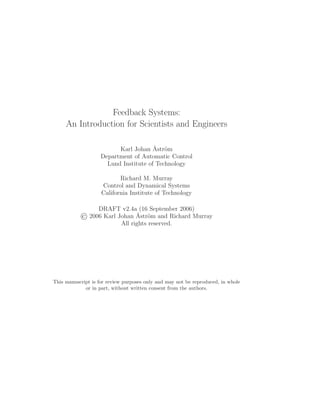





![Preface
This book provides an introduction to the basic principles and tools for
design and analysis of feedback systems. It is intended to serve a diverse
audience of scientists and engineers who are interested in understanding
and utilizing feedback in physical, biological, information, and economic
systems. To this end, we have chosen to keep the mathematical prerequi-
sites to a minimum while being careful not to sacrifice rigor in the process.
Advanced sections, marked by the “dangerous bend” symbol shown to the
right, contain material that is of a more advanced nature and can be skipped
on first reading.
This book was originally developed for use in an experimental course at
Caltech involving students from a wide variety of disciplines. The course
consisted of undergraduates at the junior and senior level in traditional en-
gineering disciplines, as well as first and second year graduate students in
engineering and science. This included graduate students in biology, com-
puter science and economics, requiring a broad approach that emphasized
basic principles and did not focus on applications in any one given area.
A web site has been prepared as a companion to this text:
http://www.cds.caltech.edu/∼murray/amwiki
The web site contains a database of frequently asked questions, supplemental
examples and exercises, and lecture materials for a course based on this text.
It also contains the source code for many examples in the book, as well as
libraries to implement the techniques described in the text. Most of the
code was originally written using MATLAB M-files, but was also tested
with LabVIEW MathScript to ensure compatibility with both packages.
Most files can also be run using other scripting languages such as Octave,
SciLab and SysQuake. [Author’s note: the web site is under construction
as of this writing and some features described in the text may not yet be
available.]
vii](https://image.slidesharecdn.com/am06-complete16sep06-150528145340-lva1-app6892/85/Am06-complete-16-sep06-7-320.jpg)


![x PREFACE
Acknowledgments
The authors would like to thank the many people who helped during the
preparation of this book. The idea for writing this book came in part from a
report on future directions in control [Mur03] to which Stephen Boyd, Roger
Brockett, John Doyle and Gunter Stein were major contributers. Kristi
Morgenson and Hideo Mabuchi helped teach early versions of the course at
Caltech on which much of the text is based and Steve Waydo served as the
head TA for the course taught at Caltech in 2003–04 and provide numerous
comments and corrections. [Author’s note: additional acknowledgments to
be added.] Finally, we would like to thank Caltech, Lund University and
the University of California at Santa Barbara for providing many resources,
stimulating colleagues and students, and a pleasant working environment
that greatly aided in the writing of this book.
Karl Johan ˚Astr¨om Richard M. Murray
Lund, Sweden Pasadena, California](https://image.slidesharecdn.com/am06-complete16sep06-150528145340-lva1-app6892/85/Am06-complete-16-sep06-10-320.jpg)
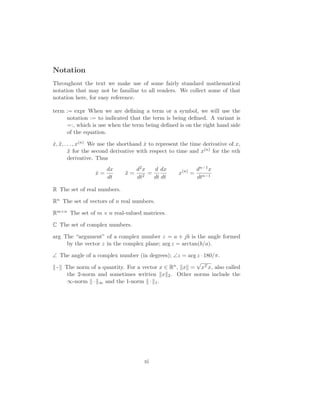

![Chapter 1
Introduction
Feedback is a central feature of life. The process of feedback governs how
we grow, respond to stress and challenge, and regulate factors such as body
temperature, blood pressure, and cholesterol level. The mechanisms operate
at every level, from the interaction of proteins in cells to the interaction of
organisms in complex ecologies.
Mahlon B. Hoagland and B. Dodson, The Way Life Works, 1995 [HD95].
In this chapter we provide an introduction to the basic concept of feedback
and the related engineering discipline of control. We focus on both historical
and current examples, with the intention of providing the context for current
tools in feedback and control. Much of the material in this chapter is adopted
from [Mur03] and the authors gratefully acknowledge the contributions of
Roger Brockett and Gunter Stein for portions of this chapter.
1.1 What is Feedback?
The term feedback is used to refer to a situation in which two (or more)
dynamical systems are connected together such that each system influences
the other and their dynamics are thus strongly coupled. By dynamical
system, we refer to a system whose behavior changes over time, often in
response to external stimulation or forcing. Simple causal reasoning about
a feedback system is difficult because the first system influences the second
and the second system influences the first, leading to a circular argument.
This makes reasoning based on cause and effect tricky and it is necessary to
analyze the system as a whole. A consequence of this is that the behavior
of feedback systems is often counterintuitive and it is therefore necessary to
resort to formal methods to understand them.
1](https://image.slidesharecdn.com/am06-complete16sep06-150528145340-lva1-app6892/85/Am06-complete-16-sep06-13-320.jpg)




![6 CHAPTER 1. INTRODUCTION
(a) (b)
Figure 1.4: Early control devices: (a) Honeywell T86 thermostat, originally intro-
duced in 1953, (b) Chrysler cruise control system, introduced in the 1958 Chrysler
Imperial (note the centrifugal governor) [Row58].
subsystems, a feature that is crucial in the operation of all large engineered
systems.
Control is also closely associated with computer science, since virtu-
ally all modern control algorithms for engineering systems are implemented
in software. However, control algorithms and software are very different
from traditional computer software. The physics (dynamics) of the system
are paramount in analyzing and designing them and their real-time nature
dominates issues of their implementation.
1.3 Feedback Examples
Feedback has many interesting and useful properties. It makes it possible
to design precise systems from imprecise components and to make physical
variables in a system change in a prescribed fashion. An unstable system
can be stabilized using feedback and the effects of external disturbances can
be reduced. Feedback also offers new degrees of freedom to a designer by
exploiting sensing, actuation and computation. In this section we survey
some of the important applications and trends for feedback in the world
around us.](https://image.slidesharecdn.com/am06-complete16sep06-150528145340-lva1-app6892/85/Am06-complete-16-sep06-18-320.jpg)




![1.3. FEEDBACK EXAMPLES 11
Figure 1.7: “Spirit”, one of the two Mars Exploratory Rovers, and Sony AIBO
Entertainment Robot. Photographs courtesy of Jet Propulsion Laboratory and
Sony.
can form an orchestra that controls our physical environment. Examples
include automobiles, smart homes, large manufacturing systems, intelligent
highways and networked city services, and enterprise-wide supply and logis-
tics chains.
Robotics and Intelligent Machines
Whereas early robots were primarily used for manufacturing, modern robots
include wheeled and legged machines capable of competing in robotic com-
petitions and exploring planets, unmanned aerial vehicles for surveillance
and combat, and medical devices that provide new capabilities to doctors.
Future applications will involve both increased autonomy and increased in-
teraction with humans and with society. Control is a central element in all
of these applications and will be even more important as the next generation
of intelligent machines are developed.
The goal of cybernetic engineering, already articulated in the 1940s and
even before, has been to implement systems capable of exhibiting highly
flexible or “intelligent” responses to changing circumstances. In 1948, the
MIT mathematician Norbert Wiener gave a widely read account of cybernet-
ics [Wie48]. A more mathematical treatment of the elements of engineering
cybernetics was presented by H.S. Tsien in 1954, driven by problems related
to control of missiles [Tsi54]. Together, these works and others of that time
form much of the intellectual basis for modern work in robotics and control.
Two accomplishments that demonstrate the successes of the field are
the Mars Exploratory Rovers and entertainment robots such as the Sony
AIBO, shown in Fig. 1.7. The two Mars Exploratory Rovers, launched by
the Jet Propulsion Laboratory (JPL), maneuvered on the surface of Mars](https://image.slidesharecdn.com/am06-complete16sep06-150528145340-lva1-app6892/85/Am06-complete-16-sep06-23-320.jpg)




![16 CHAPTER 1. INTRODUCTION
Figure 1.9: The wiring diagram of the growth signaling circuitry of the mammalian
cell [HW00].
systems We briefly highlight four application areas here.
Biological Systems. At a variety of levels of organization—from molec-
ular to cellular to organismal to populational—biology is becoming more
accessible to approaches that are commonly used in engineering: mathe-
matical modeling, systems theory, computation, and abstract approaches to
synthesis. Conversely, the accelerating pace of discovery in biological science
is suggesting new design principles that may have important practical appli-
cations in man-made systems. This synergy at the interface of biology and
engineering offers unprecedented opportunities to meet challenges in both
areas. The principles of feedback and control are central to many of the
key questions in biological engineering and will play an enabling role in the
future of this field.
A major theme currently underway in the biology community is the
science of reverse (and eventually forward) engineering of biological control
networks (such as the one shown in Figure 1.9). There are a wide variety
of biological phenomena that provide a rich source of examples for control,
including gene regulation and signal transduction; hormonal, immunological,
and cardiovascular feedback mechanisms; muscular control and locomotion;
active sensing, vision, and proprioception; attention and consciousness; and](https://image.slidesharecdn.com/am06-complete16sep06-150528145340-lva1-app6892/85/Am06-complete-16-sep06-28-320.jpg)



![20 CHAPTER 1. INTRODUCTION
(which might result from having a different number of passengers or towing
a trailer). Notice that independent of the mass (which varies by a factor
of 3), the steady state speed of the vehicle always approaches the desired
speed and achieves that speed within approximately 5 seconds. Thus the
performance of the system is robust with respect to this uncertainty.
Another early example of the use of feedback to provide robustness was
the negative feedback amplifier. When telephone communications were de-
veloped, amplifiers were used to compensate for signal attenuation in long
lines. The vacuum tube was a component that could be used to build ampli-
fiers. Distortion caused by the nonlinear characteristics of the tube amplifier
together with amplifier drift were obstacles that prevented development of
line amplifiers for a long time. A major breakthrough was invention of the
feedback amplifier in 1927 by Harold S. Black, an electrical engineer at the
Bell Telephone Laboratories. Black used negative feedback which reduces
the gain but makes the amplifier very insensitive to variations in tube char-
acteristics. This invention made it possible to build stable amplifiers with
linear characteristics despite nonlinearities of the vacuum tube amplifier.
Design of Dynamics
Another use of feedback is to change the dynamics of a system. Through
feedback, we can alter the behavior of a system to meet the needs of an
application: systems that are unstable can be stabilized, systems that are
sluggish can be made responsive, and systems that have drifting operating
points can be held constant. Control theory provides a rich collection of
techniques to analyze the stability and dynamic response of complex systems
and to place bounds on the behavior of such systems by analyzing the gains
of linear and nonlinear operators that describe their components.
An example of the use of control in the design of dynamics comes from
the area of flight control. The following quote, from a lecture by Wilbur
Wright to the Western Society of Engineers in 1901 [McF53], illustrates the
role of control in the development of the airplane:
“Men already know how to construct wings or airplanes, which
when driven through the air at sufficient speed, will not only
sustain the weight of the wings themselves, but also that of the
engine, and of the engineer as well. Men also know how to build
engines and screws of sufficient lightness and power to drive these
planes at sustaining speed ... Inability to balance and steer still
confronts students of the flying problem. ... When this one](https://image.slidesharecdn.com/am06-complete16sep06-150528145340-lva1-app6892/85/Am06-complete-16-sep06-32-320.jpg)







![28 CHAPTER 1. INTRODUCTION
0000000000
00000
1111111111
11111
000111000000111111
Present
FuturePast
t t + Td
Error
Time
Figure 1.15: A PID controller takes control action based on past, present and future
control errors.
1.6 Control Tools
The development of a control system consists of the tasks modeling, analysis,
simulation, architectural design, design of control algorithms, implementa-
tion, commissioning and operation. Because of the wide use of feedback in
a variety of applications, there has been substantial mathematical develop-
ment in the field of control theory. In many cases the results have also been
packaged in software tools that simplifies the design process. We briefly
describe some of the tools and concepts here.
Modeling
Models play an essential role in analysis and design of feedback systems.
Several sophisticated tools have been developed to build models that are
suited for control.
Models can often be obtained from first principles and there are several
modeling tools in special domains such as electric circuits and multibody sys-
tems. Since control applications cover such a wide range of domains it is also
desirable to have modeling tools that cut across traditional discipline bound-
aries. Such modeling tools are now emerging, with the models obtained by
cutting a system into subsystems and writing equations for balance of mass,
energy and momentum, and constitutive equations that describe material
properties for each subsystem. Object oriented programming can be used
very effectively to organize the work and extensive symbolic computation
can be used to simplify the equations. Models and components can then be
organized in libraries for efficient reuse. Modelica [Til01] is an example of a
modeling tool of this type.](https://image.slidesharecdn.com/am06-complete16sep06-150528145340-lva1-app6892/85/Am06-complete-16-sep06-40-320.jpg)


![1.7. FURTHER READING 31
control logic is automatically generated. This has the advantage that the
code generator can be carefully verified so that the resulting algorithm is
correct (as opposed to hand coding the algorithm, which can lead to er-
rors in translation). This autocoded control logic is then downloaded to a
dedicated computing platform with the proper interfaces to the hardware
and implemented. In addition to simple feedback algorithms, most modern
control environments allow complex decision-making logic to be constructed
via block diagrams and this is also automatically compiled and downloaded
to a computer that is connected to the hardware.
This mechanism for generating control algorithms directly from speci-
fications has vastly improved the productivity of control engineers and is
now standard practice in many application areas. It also provides a clear
framework in which new advances, such as real-time, optimization-based
control, can be transitioned to applications quickly and efficiently through
the generation of standard toolboxes.
1.7 Further Reading
The material in this section draws heavily from the report of the Panel
on Future Directions on Control, Dynamics, and Systems [Mur03]. Several
recent papers and reports highlighted successes of control [NS99] and new
vistas in control [Bro00, Kum01]. A fascinating examination of some of
the early history of control in the United States has been written by Min-
dell [Min02]. Additional historical overviews of the field have been prepared
by Bennett [Ben86a, Ben86b] and Mayr[May70], which go back as far as the
1800s. A popular book that describes many control concepts across a wide
range of disciplines is “Out of Control” by Kelly [Kel94].
There are many textbooks available that describe control systems in the
context of specific disciplines. For engineers, the textbooks by Franklin,
Powell and Emami-Naeni [FPEN05], Dorf and Bishop [DB04], Kuo and
Golnaraghi [KG02], and Seborg, Edgar and Mellichamp [SEM03] are widely
used. A number of books look at the role of dynamics and feedback in biolog-
ical systems, including Milhorn [Mil66] (now out of print), Murray [Mur04]
and Ellner and Guckenheimer [EG05]. There is not yet a textbook targeted
specifically at the physics community, although a recent tutorial article by
Bechhoefer [Bec05] covers many specific topics of interest to that community.](https://image.slidesharecdn.com/am06-complete16sep06-150528145340-lva1-app6892/85/Am06-complete-16-sep06-43-320.jpg)

![Chapter 2
System Modeling
... I asked Fermi whether he was not impressed by the agreement between
our calculated numbers and his measured numbers. He replied, “How many
arbitrary parameters did you use for your calculations?” I thought for a
moment about our cut-off procedures and said, “Four.” He said, “I remember
my friend Johnny von Neumann used to say, with four parameters I can fit
an elephant, and with five I can make him wiggle his trunk.”
Freeman Dyson on describing the predictions of his model for meson-proton
scattering to Enrico Fermi in 1953 [Dys04].
A model is a precise representation of a system’s dynamics used to answer
questions via analysis and simulation. The model we choose depends on the
questions we wish to answer, and so there may be multiple models for a single
physical system, with different levels of fidelity depending on the phenomena
of interest. In this chapter we provide an introduction to the concept of
modeling, and provide some basic material on two specific methods that are
commonly used in feedback and control systems: differential equations and
difference equations.
2.1 Modeling Concepts
A model is a mathematical representation of a physical, biological or in-
formation system. Models allow us to reason about a system and make
predictions about how a system will behave. In this text, we will mainly
be interested in models of dynamical systems describing the input/output
behavior of systems and often in so-called “state space” form.
Roughly speaking, a dynamical system is one in which the effects of
actions do not occur immediately. For example, the velocity of a car does not
33](https://image.slidesharecdn.com/am06-complete16sep06-150528145340-lva1-app6892/85/Am06-complete-16-sep06-45-320.jpg)




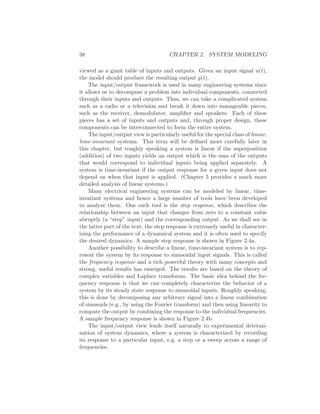








![2.2. STATE SPACE MODELS 47
where xk ∈ Rn is the state of the system at “time” k (an integer), uk ∈ Rm
is the input and yk ∈ Rp is the output. As before, f and h are smooth
mappings of the appropriate dimension. We call equation (2.9) a difference
equation since it tells us now xk+1 differs from xk. The state xk can either
be a scalar or a vector valued quanity; in the case of the latter we use
superscripts to denote a particular element of the state vector: xi
k is the
value of the ith state at time k.
Just as in the case of differential equations, it will often be the case that
the equations are linear in the state and input, in which case we can write
the system as
xk+1 = Axk + Buk
yk = Cxk + Duk.
As before, we refer to the matrices A, B, C and D as the dynamics matrix,
the control matrix, the sensor matrix and the direct term. The solution of
a linear difference equation with initial condition x0 and input u1, . . . , uT is
given by
xk = Ak
x0 +
k
i=0
Ai
Bui
yk = CAk
x0 +
k
i=0
CAi
Bui + Duk
(2.10)
Example 2.3 (Predator prey). As an example of a discrete time system,
we consider a simple model for a predator prey system. The predator prey
problem refers to an ecological system in which we have two species, one
of which feeds on the other. This type of system has been studied for
decades and is known to exhibit very interesting dynamics. Figure 2.6 shows
a historical record taken over 50 years in the population of lynxes versus
hares [Mac37]. As can been seen from the graph, the annual records of the
populations of each species are oscillatory in nature.
A simple model for this situation can be constructed using a discrete
time model by keeping track of the rate of births and deaths of each species.
Letting H represent the population of hares and L represent the population
of lynxes, we can describe the state in terms of the populations at discrete
periods of time. Letting k be the discrete time index (e.g., the day number),
we can write
Hk+1 = Hk + br(u)Hk − aLkHk
Lk+1 = Lk − df Lk + aLkHk,
(2.11)
where br(u) is the hare birth rate per unit period and as a function of the](https://image.slidesharecdn.com/am06-complete16sep06-150528145340-lva1-app6892/85/Am06-complete-16-sep06-59-320.jpg)
![48 CHAPTER 2. SYSTEM MODELING
Figure 2.6: Predator versus prey. The photograph shows a Canadian lynx and a
snowshoe hare. The graph on the right shows the populations of hares and lynxes
between 1845 and 1935 [MS93]. Photograph courtesy Rudolfo’s Usenet Animal
Pictures Gallery.
food supply u, df is the lynx death rate, and a is the interaction term. The
interaction term models both the rate at which lynxes eat hares and the
rate at which lynxes are produced by eating hares. This model makes many
simplifying assumptions—such as the fact that hares never die of old age
or causes other than being eaten—but it often is sufficient to answer basic
questions about the system.
To illustrate the usage of this system, we can compute the number of
lynxes and hares from some initial population. This is done by starting with
x0 = (H0, L0) and then using equation (2.11) to compute the populations
in the following year. By iterating this procedure, we can generate the
population over time. The output of this process for a specific choice of
parameters and initial conditions is shown in Figure 2.7. While the details
of the simulation are different from the experimental data (to be expected
given the simplicity of our assumptions), we see qualitatively similar trends
1850 1860 1870 1880 1890 1900 1910 1920
0
50
100
150
Year
Population
hares
lynxes
Figure 2.7: A simulation of the predator prey model with a = 0.007, br(u) = 0.7
and d = 0.5.](https://image.slidesharecdn.com/am06-complete16sep06-150528145340-lva1-app6892/85/Am06-complete-16-sep06-60-320.jpg)






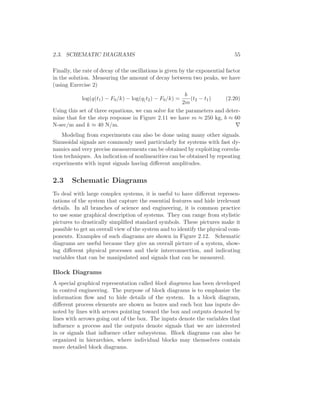









![2.4. EXAMPLES 65
Figure 2.20: An electric circuit with a Josephson junction.
of electrons. The effect has been used to design superconducting quantum
interference devices (SQUID), because switching is very fast, in the order of
picoseconds. Tunneling in the Josephson junctions is very sensitive to mag-
netic fields and can therefore be used to measure extremely small magnetic
fields, the threshold is as low as 10−14 T. Josephson junctions are also used
for other precision measurements. The standard volt is now defined as the
voltage required to produce a frequency of 483,597.9 GHz in a Josephson
junction oscillator.
A schematic diagram of a circuit with a Josephson junction is shown
in Figure 2.20. The quantum effects can be modeled by the Schr¨odinger
equation. In spite of this it turns out that the circuit can be modeled as a
system with lumped parameters. Let ϕ be the flux which is the integral of
the voltage V across the device, hence
V =
dϕ
dt
. (2.26)
It follows from quantum theory, see Feynman [Fey70], that the current I
through the device is a function of the flux ϕ
I = I0 sin kϕ, (2.27)
where I0 is a device parameter, and the Josephson parameter k is given by
k = 4π
e
h
V−1
s−1
= 2
e
h
HzV−1
, (2.28)
where e = 1.602 × 10−19 C is the charge of an electron and h = 6.62 × 10−34
V−1s−1 is Planck’s constant.](https://image.slidesharecdn.com/am06-complete16sep06-150528145340-lva1-app6892/85/Am06-complete-16-sep06-77-320.jpg)


![68 CHAPTER 2. SYSTEM MODELING
...
Router Receiver
Link
Sources
(a)
0 10 20 30 40
0
0.2
0.4
0.6
0.8
1
1.2
1.4
time (sec)
x
i
(Mb/s),b(Mb)
(b)
Figure 2.21: Congestion control simulation: (a) Multiple sources attempt to com-
municate through a router across a single link. (b) Simulation with 6 sources
starting random rates, with 2 sources dropping out at t = 20 s.
Figure 2.21 shows a simulation of 6 sources communicating across a single
link, with two sources dropping out at T = 1 s and the remaining courses
increasing their rates to compensate. Note that the solutions oscillate before
approaching their equilibrium values, but that the transmission rates and
buffer size automatically adjust depending on the number of sources.
A good presentation of the ideas behind the control principles for the
Internet are given by one of its designers in [Jac88]. The paper [Kel85] is
an early effort of analysis of the system. The book [HDPT04] gives many
interesting examples of control of computer systems. ∇
Example 2.13 (Consensus protocols in sensor networks). Sensor networks
are used in a variety of applications where we want to collect and aggregate
information over a region of space using multiple sensors that are connected
together via a communications network. Examples include monitoring en-
vironmental conditions in a geographical area (or inside a building), moni-
toring movement of animals or vehicles, or monitoring the resource loading
across a group of computers. In many sensor networks the computational
resources for the system are distributed along with the sensors and it can
be important for the set of distributed agents to reach a consensus about a
certain property across the network, such as the average temperature in a
region or the average computational load amongst a set of computers.
To illustrate how such a consensus might be achieved, we consider the
problem of computing the average value of a set of numbers that are locally
available to the individual agents. We wish to design a “protocol” (algo-
rithm) such that all agents will agree on the average value. We consider the](https://image.slidesharecdn.com/am06-complete16sep06-150528145340-lva1-app6892/85/Am06-complete-16-sep06-80-320.jpg)


![2.4. EXAMPLES 71
to the desired consensus state. A formal analysis requires tools that will
be introduced later in the text, but it can be shown that for any given
graph, we can always find a γ such that the states of the individual agents
converge to the average. A simulation demonstrating this property is shown
in Figure 2.22b.
Although we have focused here on consensus to the average value of a
set of measurements, other consensus states can be achieved through choice
of appropriate feedback laws. Examples include finding the maximum or
minimum value in a network, counting the number of nodes in a network, and
computing higher order statistical moments of a distributed quantity. ∇
Biological Systems
Biological systems are filled with feedback loops and provide perhaps the
richest source of feedback and control examples. The basic problem of
homeostasis, in which a quantity such as temperature or blood sugar level
is regulated to a fixed value, is but one of the many types of complex feed-
back interactions that can occur in molecular machines, cells, organisms and
ecosystems.
Example 2.14 (Transcriptional regulation). Transcription is the process
by which mRNA is generated from a segment of DNA. The promoter region
of a gene allows transcription to be controlled by the presence of other
proteins, which bind to the promoter region and either repress or activate
RNA polymerase (RNAP), the enzyme that produces mRNA from DNA.
The mRNA is then translated into a protein according to its nucleotide
sequence.
A simple model of the transcriptional regulation process is the use of
a Hill function [dJ02, Mur04]. Consider the regulation of a protein A with
concentration given by pA and corresponding mRNA concentration mA. Let
B be a second protein with concentration pB that represses the production
of protein A through transcriptional regulation. The resulting dynamics of
pA and mA can be written as
dmA
dt
= −τmA +
α
1 + pn
B
+ α0
dpA
dt
= β(mA − pA),
(2.33)
where α + α0 is the basal transcription rate, τ represents the rate of degre-
dation of mRNDA, α and n are parameters that describe how B represses](https://image.slidesharecdn.com/am06-complete16sep06-150528145340-lva1-app6892/85/Am06-complete-16-sep06-83-320.jpg)
![72 CHAPTER 2. SYSTEM MODELING
Figure 2.23: The repressilator genetic regulatory network: (a) a schematic diagram
of the repressilator, showing the layout of the genes in the plasmid that holds the
circuit as well as the circuit diagram (center); (b) simulation of a simple model of
the repressilator.
A and β represents both the rate of production of the protein from its cor-
responding mRNA and also the rate of degradation of A. The parameter
α0 describes the “leakiness” of the promotor and n is called the Hill coef-
ficient and relates to the cooperativity of the promotor. For simplicity we
will assume that τ = 1, which corresponds to choosing units of time that
correspond to the mRNA decay rate.
A similar model can be used when a protein activates the production of
another protein, rather than repressing it. In this case, the equations have
the form
dmA
dt
= −τmA +
αpn
B
1 + pn
B
+ α0
dpA
dt
= β(mA − pA),
(2.34)
where the variables are the same as described. Note that in the case of the
activator, if pB is zero then the production rate is α0 (versus α + α0 for
the repressor). As pB gets large, the second term in the expression for ˙mA
approaches 1 and the transcription rate becomes α + α0 (versus α0 for the
repressor). Thus we see that the activator and repressor act in opposite
fashion from each other.
As an example of how these models can be used, we consider the model of
a “repressilator”, originally due to Elowitz and Leibler [EL00]. The repressi-
lator is a synthetic circuit in which three proteins each repressor another in a
cycle. This is shown schematically in Figure 2.23a, where the three proteins
are tetR, λ cI and LacI. The basic idea of the repressilator is that if tetR](https://image.slidesharecdn.com/am06-complete16sep06-150528145340-lva1-app6892/85/Am06-complete-16-sep06-84-320.jpg)
![2.4. EXAMPLES 73
is present then it represses the production of λ cI. If λ cI is represent, then
LacI is produced (at the basal transcription rate), which in turn represses
TetR. Once TetR is repressed then λ cI is no longer repressed and so on.
If the dynamics of the circuit are designed properly, the resulting protein
concentrations will oscillate.
We can model this system using three copies of equation (2.33), with A
and B replaced by the appropriate combination of TetR, cI and LacI. The
state of the system is then given by x = (mTetR, pTetR, mcI, pcI, mLacI, pLacI).
Figure 2.23b shows the traces of the three protein concentrations for pa-
rameters α0 = 0, α = 50, β = 0.2 and n = 2 and initial conditions
x(0) = 0.2, 0.1, 0.1, 0.4, 0.3, 0.5) (from [EG05]). ∇
Example 2.15 (Hodgkin-Huxley equations1). The dynamics of the mem-
brane potential in a cell is a fundamental mechanism in discussing signaling
in cells. The Hodgkin-Huxley equations provide a simple model for studying
propagation waves in networks of neurons. The model for a single neuron
has the form
C
dV
dt
= −INa − IK − Ileak + Iinput
where V is the membrane potential, C the capacitance, INa and IK the
current caused by transport of sodium and potassium across the cell mem-
brane, Ileak is a leakage current ant Iinput is the external stimulation of the
cell. Each current obeys Ohms law, i.e.
I = g(V − E)
where g is the conductance and E the equilibrium voltage. The equilibrium
voltage is given by Nernst’s law
E =
RT
xF
log(Cout/Cin)
where R is Boltzmann’s constant, T the absolute temperature, F Faraday’s
constant, Cout and Cin the ion concentrations outside and inside the cell.
At 20◦ we have RT/F = 20 mV.
The Hodgkin-Huxley model was originally developed as a means to pre-
dict the quantitative behavior of the squid giant axon [HH52]. Hodgkin and
Huxley shared the 1963 Nobel Prize in Physiology (along with J. C. Eccles)
for analysis of the electrical and chemical events in nerve cell discharge. ∇
1
H. R. Wilson, Spikes, Decisions and Actions—Dynamical Foundations of Neuro-
science. Oxford University Press.](https://image.slidesharecdn.com/am06-complete16sep06-150528145340-lva1-app6892/85/Am06-complete-16-sep06-85-320.jpg)
![74 CHAPTER 2. SYSTEM MODELING
2.5 Further Reading
Modeling is ubiquitous in engineering and science and has a long history
in applied mathematics. For example, the Fourier series was introduced in
connection with modeling of heat conduction in solids. Models of dynamics
have been developed in many different fields, including mechanics [Gol53],
heat conduction [CJ59], fluids![BS60], vehicles [Abk69, Bla91, Ell94], cir-
cuit theory [Gui63], acoustics [Ber54] and micromechanical systems [Sen01].
Control theory requires modeling from many different domains and most
texts control theory contain several chapters on modeling using ordinary
differential equations and difference equations (see, for example, [FPEN05]).
A classic book on modeling of physical systems, especially mechanical,
electrical and thermo-fluid systems, is Cannon’s Dynamics of Physical Sys-
tems [Can03]. Two of the authors’ favorite books on modeling of biological
systems are Mathematical Biology by J. D. Murray [Mur04] and Spikes, De-
cision and Actions: The Dynamical Foundations of Neuroscience by H. R.
Wilson [Wil99]. For readers interested in learning more about object ori-
ented modeling and Modelica, the edited volume by Tiller [Til01] provides
an excellent introduction.
2.6 Exercises
1. Use the equations of motion for a balance system to derive a dynamic
model for the inverted pendulum described in Example 2.2 and verify
that for small θ they are approximated by equation (2.8).
2. (Second order system identification) Verify that equation (2.20) in
Example 2.7 is correct and use this formula and the others in the
example to compute the parameters corresponding to the step response
in Figure 2.11.
3. (Least squares system identification) Consider a nonlinear differential
equation that can be written in the form
dx
dt
=
M
i=1
αifi(x)
where fi(x) are known nonlinear functions and αi are unknown, but
constant, parameters. Suppose that we have measurements (or esti-
mates) of the state x at time instants t1, t2, . . . , tN , with N > M.](https://image.slidesharecdn.com/am06-complete16sep06-150528145340-lva1-app6892/85/Am06-complete-16-sep06-86-320.jpg)
![2.6. EXERCISES 75
Show that the parameters αi can be determined by finding the least
squares solution to a linear equation of the form
Hα = b
where α ∈ RM is the vector of all parameters and H ∈ RN×M and
b ∈ RN are appropriately defined.
4. Consider the following discrete time system
zk+1 = Azk + Buk
yk = Czk
where
z =
z1
z2
A =
a11 a12
0 a22
B =
0
1
C =
1 0
In this problem, we will explore some of the properties of this discrete
time system as a function of the parameters, the initial conditions,
and the inputs.
(a) Assume that the off diagonal element a12 = 0 and that there is
no input, u = 0. Write a closed form expression for the output of
the system from a nonzero initial condition z0 = (z1
0, z2
0) and give
conditions on a11 and a22 under which the output gets smaller as
k gets larger.
(b) Now assume that a12 = 0 and write a closed form expression
for the response of the system from a nonzero initial conditions.
Given a condition on the elements of A under which the output
gets smaller as k gets larger.
(c) Write a MATLAB program to plot the output of the system in
response to a unit step input, u[k] = 1, k ≥ 0. Plot the response
of your system with z0 = 0 and A given by
A =
0.5 1
0 0.25
5. Consider the delta-sigma converter in Example 2.10. Propose a way
to obtain an estimate of the instantaneous value of the reference signal
and its derivative from the pulsed output.](https://image.slidesharecdn.com/am06-complete16sep06-150528145340-lva1-app6892/85/Am06-complete-16-sep06-87-320.jpg)

![Chapter 3
Examples
... Don’t apply any model until you understand the simplifying assumptions
on which it is based, and you can test their validity. Catch phrase: use only
as directed. Don’t limit yourself to a single model: More than one model may
be useful for understanding different aspects of the same phenomenon. Catch
phrase: legalize polygamy.”
Saul Golomb in his 1970 paper “Mathematical Models—Uses and Limita-
tions” [Gol70].
In this chapter we present a collection of examples spanning many differ-
ent fields of science and engineering. These examples will be used throughout
the text and in exercises to illustrate different concepts. First time read-
ers may wish to focus only on a few examples with which they have the
most prior experience or insight to understand the concepts of state, input,
output, and dynamics in a familiar setting.
3.1 Cruise Control
The cruise control system of a car is one of the most common control systems
encountered in everyday life. The system attempts to keep the speed of the
car constant in spite of disturbances caused by changes in the slope of a road
and variations in the wind and road surface. The controller compensates for
these unknowns by measuring the speed of the car and adjusting the throttle
appropriately.
To model the complete system we start with the block diagram in Fig-
ure 3.1. Let v be the speed of the car and vr the desired (reference) speed.
The controller, which typically is of the proportional-integral (PI) type de-
scribed briefly in Chapter 1, receives the signals v and vr and generates a
77](https://image.slidesharecdn.com/am06-complete16sep06-150528145340-lva1-app6892/85/Am06-complete-16-sep06-89-320.jpg)
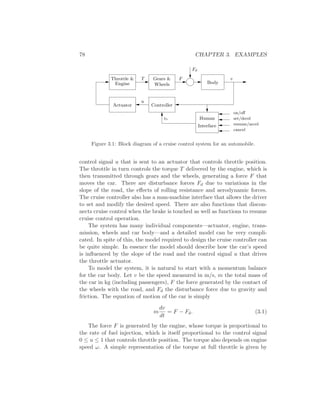



![82 CHAPTER 3. EXAMPLES
Figure 3.4: Finite state machine for cruise control system.
The controller can operate in two ways: in the normal cruise control
mode and in a tracking mode, where the integral is adjusted to match
given process inputs and outputs. The tracking mode is introduced to avoid
switching transients when the system is controlled manually. The generator
for the reference signal has three modes: a normal control mode when the
output is controlled by the set/accelerate and resume/decelerate buttons, a
tracking mode and a hold mode where the reference is held constant.
To control the overall operation of the controller and reference generator,
we use a finite state machine with four states: off, standby, cruise and hold.
The states of the controller and the reference generator in the different modes
are given in Figure 3.4. The cruise mode is the normal operating mode where
the speed can be then be decreased by pushing set/decelerate and increased
by pushing the resume/accelerate. When the system is switched on it goes
to standby mode. The cruise mode is activated by pushing the set/accelerate
button. If the brake is touched or if the gear is changed, the system goes
into hold mode and the current velocity is stored in the reference generator.
The controller is then switched to tracking mode and the reference generator
is switched to hold mode, where it holds the current velocity. Touching the
resume button then switches the system to cruise mode. The system can be
switched to standby mode from any state by pressing the cancel button.
The PI controller should be designed to have good regulation properties
and to give good transient performance when switching between resume
and control modes. Implementation of controllers and reference generators
will be discussed more fully in Chapter 10. A popular description of cruise
control system can be found on the companion web site. Many automotive
applications are discussed in detail in [BP96] and [KN00].](https://image.slidesharecdn.com/am06-complete16sep06-150528145340-lva1-app6892/85/Am06-complete-16-sep06-94-320.jpg)


![3.3. OPERATIONAL AMPLIFIER 85
a centrifugal force that attempts to diminish the lean. The effect can be
verified experimentally by biking on a straight path, creating a lean by tilting
the body and observing the steering torque required to keep the bicycle
on a straight path when leaning. Under certain conditions, the feedback
can actually stabilize the bicycle. A crude empirical model is obtained by
assuming that the blocks A and B are static gains k1 and k2 respectively:
δ = k1T − k2ϕ. (3.6)
This model neglects the dynamics of the front fork, the tire-road interaction
and the fact that the parameters depend on the velocity. A more accurate
model is obtained by the rigid body dynamics of the front fork and the
frame. Assuming small angles this model becomes
M
¨ϕ
¨δ
+ Cv0
˙ϕ
˙δ
+ (K0 + K2v2
0)
ϕ
δ
=
0
T
, (3.7)
where the elements of the 2 × 2 matrices M, C, K0 and K2 depend on
the geometry and the mass distribution of the bicycle. Even this model
is inaccurate because the interaction between tire and road are neglected.
Taking this into account requires two additional state variables.
Interesting presentations of the development of the bicycle are given in
the books by D. Wilson [Wil04] and Herlihy [Her04]. More details on bicycle
modeling is given in the paper [˚AKL05], which has many references. The
model (3.7) was presented in a paper by Whipple in 1899 [Whi99].
3.3 Operational Amplifier
The operational amplifier (op amp) is a modern implementation of Black’s
feedback amplifier. It is a universal component that is widely used for for
instrumentation, control and communication. It is also a key element in
analog computing.
Schematic diagrams of the operational amplifier are shown in Figure 3.7.
The amplifier has one inverting input (v−), one non-inverting input (v+),
and one output (vout). There are also connections for the supply voltages,
e− and e+ and a zero adjustment (offset null). A simple model is obtained
by assuming that the input currents i− and i+ are zero and that the output
is given by the static relation
vout = sat(vmin,vmax) k(v+ − v−) , (3.8)](https://image.slidesharecdn.com/am06-complete16sep06-150528145340-lva1-app6892/85/Am06-complete-16-sep06-97-320.jpg)



![3.4. WEB SERVER CONTROL 89
i0
−
+
v1
R1 R2
v2
C
Figure 3.10: Circuit diagram of a PI controller obtained by feedback around an
operational amplifier.
which implies that
vc(t) =
1
C
i(t) dt =
1
R1C
t
0
v1(τ)dτ.
The output voltage is thus given by
v2(t) = −R2i − vc = −
R2
R1
v1(t) −
1
R1C
t
0
v1(τ)dτ,
which is the input/output relation for a PI controller.
The development of operational amplifiers is based on the work of Philbrick [Lun05,
Phi48] and their usage is described in many textbooks (e.g. [CD75]). Very
good information is also available from suppliers [Jun02, Man02].
3.4 Web Server Control
Control is important to ensure proper functioning of web servers, which are
key components of the Internet. A schematic picture of a server is shown
in Figure 3.11. Requests are arriving, queued and processed by the server,
typically on a first-come-first-serve basis. There are typically large variations
in arrival rates and service rates. The queue length builds up when the
messages
x
µλ
message queuemessages
incoming outgoing
Figure 3.11: Schematic diagram of a web server.](https://image.slidesharecdn.com/am06-complete16sep06-150528145340-lva1-app6892/85/Am06-complete-16-sep06-101-320.jpg)
![90 CHAPTER 3. EXAMPLES
arrival rate is larger than the service rate. When the queue becomes too
large, service is denied using some admission control policy.
The system can be modeled in many different ways. One way is to model
each incoming request, which leads to an event-based model, where the state
is an integer that represents the queue length. The queue changes when a
request arrived or a request is served. A discrete time model that captures
these dynamics is given by the difference equation
xk+1 = xk + ui − uo, x ∈ I
where ui and uo are random variables representing incoming and outgoing
requests on the queue. These variables take on the values 0 or 1 with some
probability at each time instant. To capture the statistics of the arrival and
servicing of messages, we model each of these as a Poisson process in which
the number of events occurring in a fixed time has a given rate, with the
specific timing of events independent of the time since the last event. (The
details of random processes are beyond the scope of this text, but can be
found in standard texts such as [Pit99].)
The system can also described using a flow model by approximating
the requests and services by continuous flows and the queue length by a
continuous variable. A flow model can be obtained by making probabilistic
assumptions on arrival and service rates and computing the average queue
length. For example, assuming that the arrival and service rates are Poisson
processes with intensities λ and µ it can be shown that the average queue
length x is described by the first-order differential equation
dx
dt
= λu − µ
x
x + 1
. (3.15)
The control variable 0 ≤ u ≤ 1 is the fraction of incoming requests that are
serviced, giving an effective arrival rate of uµ. The average time to serve a
request is
Ts =
x
λ
.
If µ, λ and u are constants with µ > uλ, the queue length x approaches the
steady state value
xss =
uλ
µ − uλ
. (3.16)
Figure 3.12a shows the steady state queue length as a function of µ−uλ, the
effective service rate excess. Notice that the queue length increases rapidly
as µ − uλ approaches zero. To have a queue length less than 20 requires
µ > uλ + 0.05.](https://image.slidesharecdn.com/am06-complete16sep06-150528145340-lva1-app6892/85/Am06-complete-16-sep06-102-320.jpg)




![3.5. ATOMIC FORCE MICROSCOPE 95
Figure 3.15: Arrival rate (top) and average service delay (bottom) for an experiment
with web server control (from [HLA04]).
shown in Figure 3.15. The desired delay for the class was set to dr = 4s in all
experiments. The figure shows that the control algorithm keeps the service
time reasonably constant and that the PI controller reduces the variations
in delay compared with a pure feedforward controller.
This example illustrates that simple models can give good insight and
that nonlinear control strategies are useful. The example also illustrates
that continuous time models can be useful for phenomena that are basically
discrete. There are also converse examples. Therefore it is a good idea to
keep an open mind and master both discrete and continuous time modeling.
The book by Hellerstein et al. [HDPT04] gives many examples of use of
feedback in computer systems. The example on delay control is based on
the work of Henriksson [HLA04, Hen06].
3.5 Atomic Force Microscope
The 1986 Nobel Prize in Physics was shared by Gerd Binnig and Heinrich
Rohrer for their design of the scanning tunneling microscope (SCM). The
idea of an SCM is to bring an atomically sharp tip so close to a conducting
surface that tunneling occurs. An image is obtained by traversing the tip
and measuring the tunneling current as a function of tip position. The
image reflects the electron structure of the upper atom-layers of the sample.](https://image.slidesharecdn.com/am06-complete16sep06-150528145340-lva1-app6892/85/Am06-complete-16-sep06-107-320.jpg)


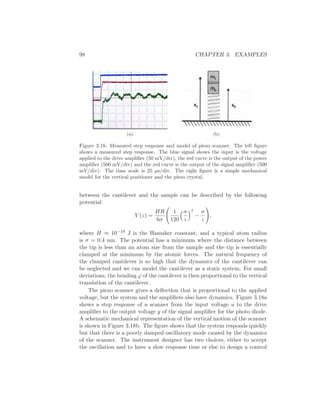
![3.6. DRUG ADMINISTRATION 99
system that can damp the oscillations which gives a faster response and a
faster imaging. Damping the oscillations is a significant challenge because
there are many oscillatory modes and they can change depending on how the
instrument is used. An instrument designer also has the choice to redesign
the mechanics so that the resonances occur at higher frequencies.
The book by Sarid [Sar91] gives a broad coverage of atomic force micro-
scopes. The interaction of atoms close to surfaces is fundamental to solid
state physics. A good source is Kittel [Kit95] where the Lennard-Jones po-
tential is discussed. Modeling and control of atomic force microscopes are
discussed by Schitter [Sch01].
3.6 Drug Administration
The phrase “take two pills three times a day” is a recommendation that we
are all familiar with. Behind this recommendation is a solution of an open
loop control problem. The key issue is to make sure that the concentration
of a medicine in a part of our bodies will be sufficiently high to be effective
but not so high that it will cause undesirable side effects. The control action
is quantized, take two pills, and sampled, every 8 hours. The prescriptions
can be based on very simple models in terms of empirical tables where the
dosage is based on the age and weight of the patient. A more sophisticated
administration of medicine is used to keep concentration of insulin and glu-
cose at a right level. In this case the substances are controlled by continuous
measurement and injection, and the control schemes are often model based.
Drug administration is clearly a control problem. To do it properly it
is necessary to understand how a drug spreads in the body after it is ad-
ministered. This topic, called pharmacokinetics, is now its own discipline
and the models used are called compartment models. They go back to 1920
when Widmark modeled propagation of alcohol in the body [WT24]. Phar-
macokinetics describes how drugs are distributed in different organs of the
body. Compartment models are now important for screening of all drugs
used by humans. The schematic diagram in Figure 3.19 illustrates the idea
of a compartment model. Compartment models are also used in many other
fields such as environmental science.
One-Compartment Model
The simplest dynamic model is obtained by assuming that the body behaves
like a single compartment: that the drug is spread evenly in the body after](https://image.slidesharecdn.com/am06-complete16sep06-150528145340-lva1-app6892/85/Am06-complete-16-sep06-111-320.jpg)
![100 CHAPTER 3. EXAMPLES
Figure 3.19: Schematic diagram of the circulation system (from Teorell [Teo37]).
it has been administered, and that it is then removed at a rate proportional
to the concentration. Let c be the concentration, V the volume and q the
outflow rate or the clearance. Converting the description of the system into
differential equations, the model becomes
V
dc
dt
= −qc. (3.20)
This equation has the solution
c(t) = c0e−qt/V
= c0e−kt
,
which shows that the concentration decays exponentially after an injection.
The input is introduced implicitly as an initial condition in the model (3.20).
The way the input enters the model depends on how the drug is adminis-
tered. The input can be represented as a mass flow into the compartment
where the drug is injected. A pill that is dissolved can also be interpreted
as an input in terms of a mass flow rate.
The model (3.20) is called a a one-compartment model or a single pool
model. The parameter q/V is called the elimination rate constant. The
simple model is often used in studies where the concentration is measured
in the blood plasma. By measuring the concentration at a few times, the
initial concentration can be obtained by extrapolation. If the total amount
of injected substance is known, the volume V can then be determined as
V = m/c0; this volume is called the the apparent volume of distribution.
This volume is larger than the real volume if the concentration in the plasma
is lower than in other parts of the body. The model (3.20) is very simple
and there are large individual variations in the parameters. The parameters
V and q are often normalized by dividing with the weight of the person.](https://image.slidesharecdn.com/am06-complete16sep06-150528145340-lva1-app6892/85/Am06-complete-16-sep06-112-320.jpg)

![102 CHAPTER 3. EXAMPLES
model can be written as
dx
dt
=
−k0 − k1 k2
k1 −k2
x +
c0
0
u
y =
0 1/V2
x.
(3.21)
In this model we have used the total mass of the drug in each compartment
as state variables. If we instead choose to use the concentrations as state
variables, the model becomes
dc
dt
=
−k0 − k1 k1
k2 −k2
c +
b0
0
u
y =
0 1
x,
(3.22)
where b0 = c0/V1. Mass is called an extensive variable and concentration is
called an intensive variable.
The papers by Widmark and Tandberg [WT24] and Teorell [Teo37] are
classics. Pharmacokinetics is now an established discipline with many text-
books [Dos68, Jac72, GP82]. Because of its medical importance pharmacoki-
netics is now an essential component of drug development. Compartment
models are also used in other branches of medicine and in ecology. The
problem of determining rate coefficients from experimental data is discussed
in [B˚A70] and [God83].
3.7 Population Dynamics
Population growth is a complex dynamic process that involves the interac-
tion of one or more species with their environment and the larger ecosystem.
The dynamics of population groups are interesting and important in many
different areas of social and environmental policy. There are examples where
new species have been introduced in new habitats, sometimes with disas-
trous results. There are also been attempts to control population growth
both through incentives and through legislation. In this section we describe
some of the models that can be used to understand how populations evolve
with time and as a function of their environment.
Simple Growth Model
Let x the the population of a species at time t. A simple model is to assume
that the birth and death rates are proportional to the total population. This](https://image.slidesharecdn.com/am06-complete16sep06-150528145340-lva1-app6892/85/Am06-complete-16-sep06-114-320.jpg)



![106 CHAPTER 3. EXAMPLES
0 5 10 15 20 25 30 35 40 45 50
0
50
100
0 5 10 15 20 25 30 35 40 45 50
0
2
4
0 5 10 15 20 25 30 35 40 45 50
0
10
20
30
x
ug
t
Figure 3.22: Simulation of a fishery. The curves show total biomass x, harvesting
rate u and revenue rate g as a function of time t. The fishery is modeled by
equations (3.25), (3.26), (3.27) with parameters xc = 100, a = 0.1, b = 1 and c = 1.
Initially fishing is unrestricted at rate u = 3, at time t = 15 fishing is changed to
harvesting at a sustainable rate, accomplished by a PI controller with parameters
k = 0.5 and ki = 0.5.
The rate of revenue has a maximum
r0 =
r(c − abxc)2
4abxc
, (3.30)
for
x0 =
xc
2
+
c
2ab
. (3.31)
Figure 3.22 shows a simulation of a fishery. The system is initially in equi-
librium with x = 100. Fishing begins with constant harvesting rate u = 3
at time t = 0. The initial revenue rate is large, but it drops rapidly as the
population decreases. At time t = 12 the revenue rate is practically zero.
The fishing policy is changed to a sustainable strategy at time t = 15. This
is accomplished by using a PI controller where the reference is the optimal
sustainable population size x0 = 55, given by equation (3.31). The feedback
stops harvesting for a period but the biomass increases rapidly. At time
t = 28 the harvesting rate increases rapidly and a sustainable steady state
is reached in a short time.
Volume I of the two volume set by J. Murray [Mur04] give a broad
coverage of population dynamics. Maintaining a sustainable fish population](https://image.slidesharecdn.com/am06-complete16sep06-150528145340-lva1-app6892/85/Am06-complete-16-sep06-118-320.jpg)
![3.8. EXERCISES 107
is a global problem that has created many controversies and conflicts. A
detailed mathematical treatment is given in [?]. The mathematical analyses
has influenced international agreement on fishing.
3.8 Exercises
1. Consider the cruise control example described in Section 3.1. Build a
simulation that recreates the response to a hill shown in Figure 3.3b
and show the effects of increasing and decreasing the mass of the car
by 25%. Redesign the controller (using trail and error is fine) so that
it returns to the within 10% of the desired speed within 3 seconds of
encountering the beginning of the hill.
2. Consider the inverted pendulum model of the bicycle given in Fig-
ure 3.6. Assume that the block labeled body is modeled by equa-
tion (3.5) and that the front fork is modeled by (3.6). Derive the
equations for the closed loop. Show that when T = 0 the equation
is the same as for a mass spring damper system. Also show that
the spring coefficient is negative for low velocities but positive if the
velocity is sufficiently large.
3. Show that the dynamics of a bicycle frame given by equation (3.5) can
be written in state space form as
d
dt
x1
x2
=
0 mgh/J
1 0
x1
x2
+
1
0
u
y =
Dv0
bJ
mv2
0h
bJ
x,
where the input u is the torque applied to the handle bars and the
output y is the title angle ϕ. What do the states x1 and x2 represent?
4. Combine the bicycle model given by equation (3.5) and the model for
steering kinematics in Example 2.8 to obtain a model that describes
the path of the center of mass of the bicycle.
5. Consider the op amp circuit shown below:](https://image.slidesharecdn.com/am06-complete16sep06-150528145340-lva1-app6892/85/Am06-complete-16-sep06-119-320.jpg)

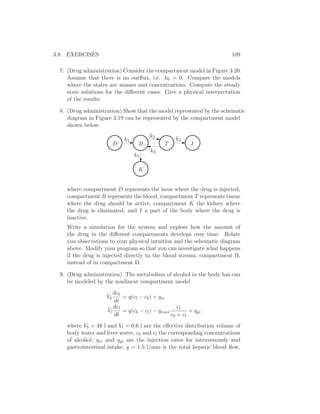




![114 CHAPTER 4. DYNAMIC BEHAVIOR
Numerical Solutions
One of the benefits of the computer revolution that is that it is very easy
to obtain a numerical solution of a differential equation when the initial
condition is given. A nice consequence of this is as soon as we have a model
in the form of equation (4.2), it is straightforward to generate the behavior
of x for different initial conditions, as we saw briefly in the previous chapter.
Modern computing environments such as LabVIEW, MATLAB and Math-
ematica allow simulation of differential equations as a basic operation. For
example, these packages provides several tools for representing, simulating,
and analyzing ordinary differential equations of the form in equation (4.2).
To define an ODE in MATLAB or LabVIEW, we define a function repre-
senting the right hand side of equation (4.2):
function xdot = system(t, x)
xdot(1) = F1(x);
xdot(2) = F2(x);
...
Each expression Fi(x) takes a (column) vector x and returns the ith el-
ement of the differential equation. The second argument to the function
system, t, represents the current time and allows for the possibility of time-
varying differential equations, in which the right hand side of the ODE in
equation (4.2) depends explicitly on time.
ODEs defined in this fashion can be simulated by using the ode45 com-
mand:
ode45(’file’, [0,T], [x10, x20, ..., xn0])
The first argument is the name of the function defining the ODE, the second
argument gives the time interval over which the simulation should be per-
formed and the final argument gives the vector of initial conditions. Similar
capabilities exist in other packages such as Octave and Scilab.
Example 4.2 (Balance system). Consider the balance system given in Ex-
ample 2.1 and reproduced in Figure 4.2a. Suppose that a coworker has
designed a control law that will hold the position of the system steady in
the upright position at p = 0. The form of the control law is
F = −Kx,
where x = (p, θ, ˙p, ˙θ) ∈ R4 is the state of the system, F is the input, and
K = (k1, k2, k3, k4) is the vector of “gains” for the control law.](https://image.slidesharecdn.com/am06-complete16sep06-150528145340-lva1-app6892/85/Am06-complete-16-sep06-126-320.jpg)










![4.3. STABILITY 125
F
θ
m
l
−6 −4 −2 0 2 4 6
−2
−1
0
1
2
x
1
x2
(a) (b) (c)
Figure 4.11: Phase portrait for a damped inverted pendulum: (a) diagram of the
inverted pendulum system; (b) phase portrait with θ ∈ [2π, 2π]; (c) phase portrait
with θ periodic.
Example 4.8 (Congestion control). The model for congestion control in a
network consisting of a single computer connected to a router, introduced
in Example 2.12, is given by
dx
dt
= −b
x2
2
+ (bmax − b)
db
dt
= x − c,
where x is the transmission rate from the source and b is the buffer size
of the router. The phase portrait is shown in Figure 4.12 for two different
parameter values. In each case we see that the system converges to an
equilibrium point in which the full capacity of the link is used and the
router buffer is not at capacity. The horizontal and vertical lines on the
plots correspond to the router buffer limit and link capacity limits. When
the system is operating outside these bounds, packets are being lost.
We see from the phase portrait that the equilibrium point at
x∗
= c b∗
=
2bmax
2 + c2
,
is stable, since all initial conditions result in trajectories that converge to
this point. Note also that some of the trajectories cross outside of the region
where x > 0 and b > 0, which is not possible in the actual system; this shows
some of the limits of this model away from the equilibrium points. A more
accurate model would use additional nonlinear elements in the model to
insure that the quantities in the model always stayed positive. ∇](https://image.slidesharecdn.com/am06-complete16sep06-150528145340-lva1-app6892/85/Am06-complete-16-sep06-137-320.jpg)





![4.3. STABILITY 131
As this example illustrates, Lyapunov functions are not unique and hence
we can use many different methods to find one. It turns out that Lyapunov
functions can always be found for any stable system (under certain condi-
tions) and hence one knows that if a system is stable, a Lyapunov function
exists (and vice versa). Recent results using “sum of squares” methods have
provided systematic approaches for finding Lyapunov systems [PPP02]. Sum
of squares techniques can be applied to a broad variety of systems, including
systems whose dynamics are described by polynomial equations as well as
“hybrid” systems, which can have different models for different regions of
state space.
Lyapunov Functions for Linear Systems
For a linear dynamical system of the form
˙x = Ax
it is possible to construct Lyapunov functions in a systematic manner. To
do so, we consider quadratic functions of the form
V (x) = xT
Px
where P ∈ Rn×x is a symmetric matrix (P = PT ). The condition that
V ≻ 0 is equivalent to the condition that P is a positive definite matrix:
xT
Px > 0 for all x = 0,
which we write as P > 0. It can be shown that if P is symmetric and
positive definite then all of its eigenvalues are real and positive.
Given a candidate Lyapunov function, we can now compute its derivative
along flows of the system:
dV
dt
=
∂V
∂x
dx
dt
= xT
(AT
P + PA)x.
The requirement that ˙V ≺ 0 (for asymptotic stability) becomes a condition
that the matrix Q = AT P + PA be negative definite:
xT
Qx < 0 for all x = 0.
Thus, to find a Lyapunov function for a linear system it is sufficient to choose
a Q < 0 and solve the Lyapunov equation:
AT
P + PA = Q.
This is a linear equation in the entries of P and hence it can be solved using
linear algebra. The following examples illustrate its use.](https://image.slidesharecdn.com/am06-complete16sep06-150528145340-lva1-app6892/85/Am06-complete-16-sep06-143-320.jpg)








![140 CHAPTER 4. DYNAMIC BEHAVIOR
0 5 10 15 20
0
0.005
0.01
0.015
0.02
T
h
r
l
unstable
stable stable
(a)
0 5 10 15 20
0
100
200
300
400
T
h
L
(b)
Figure 4.17: Bifurcation analysis of the predator prey system: (a) parametric stabil-
ity diagram showing the regions in parameter space for which the system is stable;
(b) bifurcation diagram showing the location and stability of the equilibrium point
as a function of Th. The dotted lines indicate the upper and lower bounds for the
limit cycle at that parameter value (computed via simulation). The nominal values
of the parameters in the model are rh = 0.02, K = 500, a = 0.03, Th = 5, rl = 0.01
and k = 0.2.
Parametric stability diagrams and bifurcation diagrams can provide valu-
able insights into the dynamics of a nonlinear system. It is usually neces-
sary to careful choose the parameters that one plots, including combining
the natural parameters of the system to eliminate extra parameters when
possible.
Control of bifurcations via feedback
Now consider a family of control systems
˙x = F(x, u, µ), x ∈ Rn
, u ∈ Rm
, µ ∈ Rk
, (4.13)
where u is the input to the system. We have seen in the previous sections
that we can sometimes alter the stability of the system by choice of an
appropriate feedback control, u = α(x). We now investigate how the control
can be used to change the bifurcation characteristics of the system. As in
the previous section, we rely on examples to illustrate the key points. A
more detailed description of the use of feedback to control bifurcations can
be found in the work of Abed and co-workers [LA96].
A simple case of bifurcation control is when the system can be stabilized
near the bifurcation point through the use of feedback. In this case, we](https://image.slidesharecdn.com/am06-complete16sep06-150528145340-lva1-app6892/85/Am06-complete-16-sep06-152-320.jpg)
![4.5. FURTHER READING 141
can completely eliminate the bifurcation through feedback, as the following
simple example shows.
Example 4.17 (Stabilization of the pitchfork bifurcation). Consider the
subcritical pitchfork example from the previous section, with a simple addi-
tive control:
˙x = µx + x3
+ u.
Choosing the control law u = −kx, we can stabilize the system at the
nominal bifurcation point µ = 0 since µ − k < 0 at this point. Of course,
this only shifts the bifurcation point and so k must be chosen larger than
the maximum value of µ that can be achieved.
Alternatively, we could choose the control law u = −kx3 with k > 1.
This changes the sign of the cubic term and changes the pitchfork from a
subcritical bifurcation to a supercritical bifurcation. The stability of the x =
0 equilibrium point is not changed, but the system operating point moves
slowly away from zero after the bifurcation rather than growing without
bound. ∇
4.5 Further Reading
The field of dynamical systems has a rich literature that characterizes the
possible features of dynamical systems and describes how parametric changes
in the dynamics can lead to topological changes in behavior. A very read-
able introduction to dynamical systems is given by Strogatz [Sto94]. More
technical treatments include Guckenheimer and Holmes [GH83] and Wig-
gins [Wig90]. For students with a strong interest in mechanics, the text by
Marsden and Ratiu [MR94] provides a very elegant approach using tools
from differential geometry. Finally, very nice treatments of dynamical sys-
tems methods in biology are given by Wilson [Wil99] and Ellner and Guck-
enheimer [EG05].
There is a large literature on Lyapunov stability theory. We highly
recommend the very comprehensive treatment by Khalil [Kha92].
4.6 Exercises
1. Consider the cruise control system described in Section 3.1. Plot the
phase portrait for the combined vehicle dynamics and PI compensator
with k = 1 and ki = 0.5.](https://image.slidesharecdn.com/am06-complete16sep06-150528145340-lva1-app6892/85/Am06-complete-16-sep06-153-320.jpg)
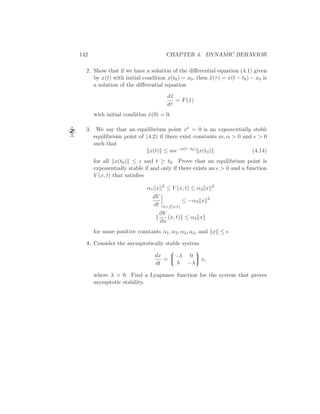
![Chapter 5
Linear Systems
Few physical elements display truly linear characteristics. For example the
relation between force on a spring and displacement of the spring is always
nonlinear to some degree. The relation between current through a resistor and
voltage drop across it also deviates from a straight-line relation. However, if
in each case the relation is ?reasonably? linear, then it will be found that the
system behavior will be very close to that obtained by assuming an ideal, linear
physical element, and the analytical simplification is so enormous that we
make linear assumptions wherever we can possibly to so in good conscience.
R. Cannon, Dynamics of Physical Systems, 1967 [Can03].
In Chapters 2–4 we considered the construction and analysis of differen-
tial equation models for physical systems. We placed very few restrictions
on these systems other than basic requirements of smoothness and well-
posedness. In this chapter we specialize our results to the case of linear,
time-invariant, input/output systems. This important class of systems is
one for which a wealth of analysis and synthesis tools are available, and
hence it has found great utility in a wide variety of applications.
5.1 Basic Definitions
We have seen several examples of linear differential equations in the ex-
amples of the previous chapters. These include the spring mass system
(damped oscillator) and the operational amplifier in the presence of small
(non-saturating) input signals. More generally, many physical systems can
be modeled very accurately by linear differential equations. Electrical cir-
cuits are one example of a broad class of systems for which linear models can
be used effectively. Linear models are also broadly applicable in mechani-
143](https://image.slidesharecdn.com/am06-complete16sep06-150528145340-lva1-app6892/85/Am06-complete-16-sep06-155-320.jpg)

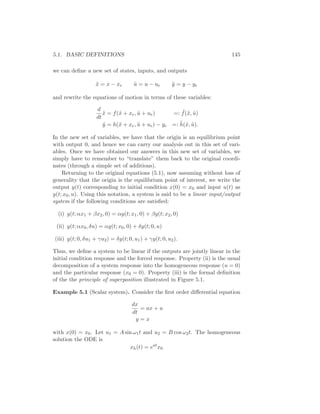


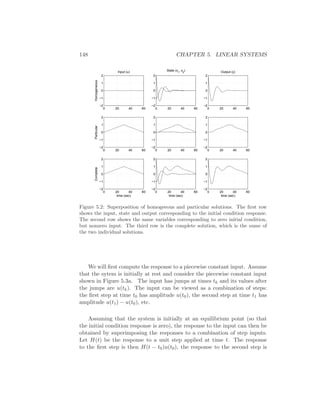






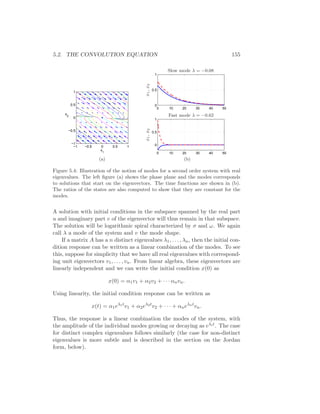








![164 CHAPTER 5. LINEAR SYSTEMS
written as
J =
J1 0 . . . 0
0 J2 0
0 . . .
... 0
0 . . . Jk
where Ji =
λi 1 0 . . . 0
0 λi 1 0
...
...
...
...
0 . . . 0 λi 1
0 . . . 0 0 λi
.
(5.16)
Each matrix Ji is called a Jordan block and λi for that block corresponds to
an eigenvalue of J.
Theorem 5.5 (Jordan decomposition). Any matrix A ∈ Rn×n can be trans-
formed into Jordan form with the eigenvalues of A determining λi in the
Jordan form.
Proof. See any standard text on linear algebra, such as Strang [Str88].
Converting a matrix into Jordan form can be very complicated, although
MATLAB can do this conversion for numerical matrices using the Jordan
function. The structure of the resulting Jordan form is particularly inter-
esting since there is no requirement that the individual λi’s be unique, and
hence for a given eigenvalue we can have one or more Jordan blocks of dif-
ferent size. We say that a Jordan block Ji is trivial if Ji is a scalar (1 × 1
block).
Once a matrix is in Jordan form, the exponential of the matrix can be
computed in terms of the Jordan blocks:
eJ
=
eJ1 0 . . . 0
0 eJ2 0
0 . . .
... 0
0 . . . eJk .
(5.17)
This follows from the block diagonal form of J. The exponentials of the
Jordan blocks can in turn be written as
eJit
=
eλit t eλit t2
2! eλit . . . tn−1
(n−1)! eλit
0 eλit t eλit . . . tn−2
(n−2)! eλit
eλit ...
... t eλit
0 eλit
(5.18)](https://image.slidesharecdn.com/am06-complete16sep06-150528145340-lva1-app6892/85/Am06-complete-16-sep06-176-320.jpg)
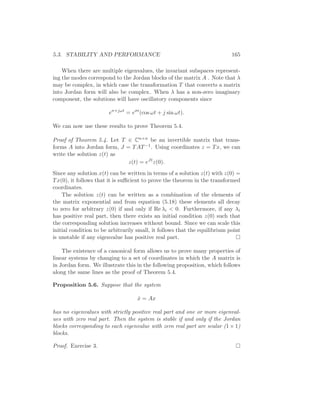












![178 CHAPTER 5. LINEAR SYSTEMS
0 5 10 15 20 25 30
19
19.5
20
20.5
0 5 10 15 20 25 30
0
0.5
1
ThrottleVelocity[m/s]
Time [s]
Figure 5.14: Simulated response of a vehicle with PI cruise control as it climbs a
hill with a slope of 4◦
. The full lines is the simulation based on a nonlinear model
and the dashed line shows the corresponding simulation using a linear model. The
controller gains are kp = 0.5 and ki = 0.1.
with an equilibrium point at x = xe, u = ue. Without loss of generality,
we assume that xe = 0 and ue = 0, although initially we will consider the
general case to make the shift of coordinates explicit.
In order to study the local behavior of the system around the equilib-
rium point (xe, ue), we suppose that x − xe and u − ue are both small, so
that nonlinear perturbations around this equilibrium point can be ignored
compared with the (lower order) linear terms. This is roughly the same type
of argument that is used when we do small angle approximations, replacing
sin θ with θ and cos θ with 1 for θ near zero.
In order to formalize this idea, we define a new set of state variables z,
inputs v, and outputs w:
z = x − xe v = u − ue w = y − h(xe, ue).
These variables are all close to zero when we are near the equilibrium point,
and so in these variables the nonlinear terms can be thought of as the higher
order terms in a Taylor series expansion of the relevant vector fields (assum-
ing for now that these exist).
Example 5.11. Consider a simple scalar system,
˙x = 1 − x3
+ u.](https://image.slidesharecdn.com/am06-complete16sep06-150528145340-lva1-app6892/85/Am06-complete-16-sep06-190-320.jpg)



![182 CHAPTER 5. LINEAR SYSTEMS
then the resulting dynamics become
m
dv
dt
= u′
+ d (5.37)
where d = mg sin θ is the disturbance force due the slope of the road. If
we now define a feedback law for u′ (such as a PID controller), we can use
equation (5.36) to compute the final input that should be commanded.
Equation (5.37) is a linear differential equation. We have essentially
“inverted out” the nonlinearity through the use of the feedback law (5.36).
This requires that we have an accurate measurement of the vehicle velocity
v as well as an accurate model of the torque characteristics of the engine,
gear ratios, drag and friction characteristics and mass of the car. While such
a model is not generally available (remembering that the parameter values
can change), if we design a good feedback law for u′, then we can achieve
robustness to these uncertainties. ∇
More generally, we say that a system of the form
dx
dt
= f(x, u)
y = h(x)
is feedback linearizable if we can find a control law u = α(x, v) such that
the resulting closed loop system is input/output linear with input v and
output u. To fully characterize such systems is beyond the scope of this
text, but we note that in addition to changes in the input, we must also
allow for (nonlinear) changes in the states that are used to describe the
system, keeping only the input and output variables fixed. More details
of this process can be found in the the textbooks by Isidori [Isi89] and
Khalil [Kha92].
One case the comes up relatively frequently, and is hence worth special
mention, is the set of mechanical systems of the form
M(q)¨q + C(q, ˙q) ˙q + N(q, ˙q) = B(q)u.
Here q ∈ Rn is the configuration of the mechanical system, M(q) ∈ Rn×n
is the configuration-dependent inertia matrix, C(q, ˙q) ˙q ∈ Rn represents the
Coriolis forces, N(q, ˙q) ∈ Rn are additional nonlinear forces (such as stiffness
and friction) and B(q) ∈ Rn×p is the input matrix. If p = n then we have
the same number of inputs and configuration variables and if we further](https://image.slidesharecdn.com/am06-complete16sep06-150528145340-lva1-app6892/85/Am06-complete-16-sep06-194-320.jpg)
![5.6. FURTHER READING 183
have that B(q) is an invertible matrix for all configurations q, then we can
choose
u = B−1
(q) (M(q)v − C(q, ˙q) ˙q − N(q, ˙q)) . (5.38)
The resulting dynamics become
M(q)¨q = M(q)v =⇒ ¨q = v,
which is a linear system. We can now use the tools of linear systems theory
to analyze and design control laws for the linearized system, remembering
to apply equation (5.38) to obtain the actual input that will be applied to
the system.
This type of control is common in robotics, where it goes by the name
of computed torque, and aircraft flight control, where it is called dynamic
inversion.
Local Stability of Nonlinear Systems
Having constructed a linearized model around an equilibrium point, we can
now ask to what extent this model predicts the behavior of the original
nonlinear system. The following theorem gives a partial answer for the case
of stability.
Theorem 5.7. Consider the system (5.31) and let A ∈ Rn×n be defined as
in equations (5.32) and (5.33). If the real part of the eigenvalues of A are
strictly less than zero, then xe is a locally asymptotically stable equilibrium
point of (5.31).
This theorem shows that global asymptotic stability of the linearization
implies local asymptotic stability of the original nonlinear system. The esti-
mates provided by the proof of the theorem can be used to give a (conserva-
tive) bound on the domain of attraction of the origin. Systematic techniques
for estimating the bounds on the regions of attraction of equilibrium points
of nonlinear systems is an important area of research and involves searching
for the “best” Lyapunov functions.
The proof of this theorem is the beyond the scope of this text, but can
be found in [Kha92].
5.6 Further Reading
The idea to characterize dynamics by considering the responses to step in-
puts is due to Heaviside. The unit step is therefore also called the Heaviside](https://image.slidesharecdn.com/am06-complete16sep06-150528145340-lva1-app6892/85/Am06-complete-16-sep06-195-320.jpg)
![184 CHAPTER 5. LINEAR SYSTEMS
step function. The majority of the material in this chapter is very classical
and can be found in most books on dynamics and control theory, includ-
ing early works on control such as James, Nichols and Phillips [JNP47], and
more recent textbooks such as Franklin, Powell and Emami-Naeni [FPEN05]
and Ogata [Oga01]. The material on feedback linearization is typically pre-
sented in books on nonlinear control theory, such as Khalil [Kha92]. Tracer
methods are described in [She62].
5.7 Exercises
1. Compute the full solution to the couple spring mass system in Ex-
ample 5.6 by transforming the solution for the block diagonal system
back into the original set of coordinates. Show that the system is
asymptotically stable if m, b and k are all greater than zero.
2. Using the computation for the matrix exponential, show that equa-
tion (5.18) holds for the case of a 3×3 Jordan block. (Hint: decompose
the matrix into the form S + N where S is a diagonal matrix.)
3. Prove Proposition 5.6.
4. Show that the step response for an asymptotically stable linear system
is given by equation (5.20).
5. Consider a first order system of the form
˙x = −τx + u
y = x.
We say that the parameter τ is the time constant for the system since
the zero input system approaches the origin as eτt. For a first order
system of this form, show that the rise time of the system is approxi-
mately 2τ, a 5% settling time corresponds to approximately 3τ and a
2% settling time corresponds to approximately 4τ.
6. Show that a signal u(t) can be decomposed in terms of the impulse
function δ(t) as
u(t) =
t
0
δ(t − τ)u(τ) dτ
and use this decomposition plus the principle of superposition to show
that the response of a linear system to an input u(t) (assuming zero](https://image.slidesharecdn.com/am06-complete16sep06-150528145340-lva1-app6892/85/Am06-complete-16-sep06-196-320.jpg)


![Chapter 6
State Feedback
Intuitively, the state may be regarded as a kind of information storage or
memory or accumulation of past causes. We must, of course, demand that
the set of internal states Σ be sufficiently rich to carry all information about
the past history of Σ to predict the effect of the past upon the future. We do
not insist, however, that the state is the least such information although this
is often a convenient assumption.
R. E. Kalman, P. L. Falb and M. A. Arbib, 1969 [KFA69].
This chapter describes how feedback of a system’s state can be used
shape the local behavior of a system. The concept of reachability is intro-
duced and used to investigate how to “design” the dynamics of a system
through assignment of its eigenvalues. In particular, it will be shown that
under certain conditions it is possible to assign the system eigenvalues to
arbitrary values by appropriate feedback of the system state.
6.1 Reachability
One of the fundamental properties of a control system is what set of points in
the state space can be reached through the choice of a control input. It turns
out that the property of “reachability” is also fundamental in understanding
the extent to which feedback can be used to design the dynamics of a system.
Definition
We begin by disregarding the output measurements of the system and fo-
cusing on the evolution of the state, given by
dx
dt
= Ax + Bu, (6.1)
187](https://image.slidesharecdn.com/am06-complete16sep06-150528145340-lva1-app6892/85/Am06-complete-16-sep06-199-320.jpg)
![188 CHAPTER 6. STATE FEEDBACK
x0
x(T)
R(x0, ≤ T)
(a) (b)
Figure 6.1: The reachable set for a control system: (a) the set R(x0, ≤ T) is the set
of points reachable from x0 in time less than T; (b) phase portrait for the double
integrator showing the natural dynamics (horizontal arrows), the control inputs
(vertical arrows) and a sample path to the origin.
where x ∈ Rn, u ∈ R, A is an n × n matrix and B an n × 1 matrix. A
fundamental question is whether it is possible to find control signals so that
any point in the state space can be reached through some choice of input.
To study this, we define the reachable set R(x0, ≤ T) as the set of all points
xf such that there exists an input u(t), 0 ≤ t ≤ T that steers the system
from x(0) = x0 to x(T) = xf , as illustrated in Figure 6.1.
Definition 6.1 (Reachability). A linear system is reachable if for any x0, xf ∈
Rn there exists a T > 0 and u: [0, T] → R such that the corresponding so-
lution satisfies x(0) = x0 and x(T) = xf .
The set of points that we are most interested in reaching is the set of
equilibrium points of the system (since we can remain at those points once
we get there). The set of all possible equilibria for constant controls is given
by
E = {xe : Axe + bue = 0 for some ue ∈ R}.
This means that possible equilibria lie in a one (or possibly higher) dimen-
sional subspace. If the matrix A is invertible this subspace is spanned by
A−1B.
In addition to reachability of equilibrium points, we can also ask whether
it is possible to reach all points in the state space in a transient fashion. The
following example provides some insight into the possibilities.
Example 6.1 (Double integrator). Consider a linear system consisting of
a double integrator, whose dynamics are given by
˙x1 = x2
˙x2 = u.](https://image.slidesharecdn.com/am06-complete16sep06-150528145340-lva1-app6892/85/Am06-complete-16-sep06-200-320.jpg)

![190 CHAPTER 6. STATE FEEDBACK
Similarly we find that the response to the derivative of a impulse function
is
d2x
dt2
= AeAt
B.
Continuing this process and using the linearity of the system, the input
u(t) = α1δ(t) + α2
˙δ(t) + α¨δ(t) + · · · + αnδ(n−1)
(t)
gives the state
x(t) = α1eAt
B + α2AeAt
B + α3A2
eAt
B + · · · + αnAn−1
eAt
B.
Hence, right after the initial time t = 0, denoted t = 0+, we have
x(0+) = α1B + α2AB + α3A2
B + · · · + αnAn−1
B.
The right hand is a linear combination of the columns of the matrix
Wr =
B AB · · · An−1B
. (6.3)
To reach an arbitrary point in the state space we thus require that there are
n linear independent columns of the matrix Wr. The matrix is called the
reachability matrix.
An input consisting of a sum of impulse functions and their derivatives
is a very violent signal. To see that an arbitrary point can be reached with
smoother signals we can also argue as follows. Assuming that the initial
condition is zero, the state of a linear system is given by
x(t) =
t
0
eA(t−τ)
Bu(τ)dτ =
t
0
eAτ
Bu(t − τ)dτ.
It follows from the theory of matrix functions, specifically the Cayley-Hamilton
theorem [Str88] that
eAτ
= Iα0(τ) + Aα1(τ) + · · · + An−1
αn−1(τ),
where αi(τ) are scalar functions, and we find that
x(t) = B
t
0
α0(τ)u(t − τ) dτ + AB
t
0
α1(τ)u(t − τ) dτ+
· · · + An−1
B
t
0
αn−1(τ)u(t − τ) dτ.
Again we observe that the right hand side is a linear combination of the
columns of the reachability matrix Wr given by equation (6.3). This basic
approach leads to the following theorem.](https://image.slidesharecdn.com/am06-complete16sep06-150528145340-lva1-app6892/85/Am06-complete-16-sep06-202-320.jpg)
![6.1. REACHABILITY 191
l
M
F
p
θ
m
(a) (b)
Figure 6.2: Balance system: (a) Segway human transportation system and (b)
simplified diagram.
Theorem 6.1. A linear system is reachable if and only the reachability
matrix Wr is invertible.
The formal proof of this theorem is beyond the scope of this text, but
follows along the lines of the sketch above and can be found in most books
on linear control theory, such as [CD91]. We illustrate the concept of reach-
ability with the following example.
Example 6.2 (Reachability of balance systems). Consider the balance sys-
tem introduced in Example 2.1 and shown in Figure 6.2. Recall that this
system is a model for a class of examples in which the center of mass is
balanced above a pivot point. One example is the Segway transportation
system shown in the left hand figure, in which a natural question to ask is
whether we can move from one stationary point to another by appropriate
application of forces through the wheels.
The nonlinear equations of motion for the system are given in equa-
tion (2.7) and repeated here:
(M + m)¨p − ml cos θ ¨θ = −c ˙p + ml sin θ ˙θ2
+ F
(J + ml2
)¨θ − ml cos θ ¨p = −γ ˙+θmgl sin θ,
(6.4)
For simplicity, we take c = γ = 0. Linearizing around the equilibrium point](https://image.slidesharecdn.com/am06-complete16sep06-150528145340-lva1-app6892/85/Am06-complete-16-sep06-203-320.jpg)
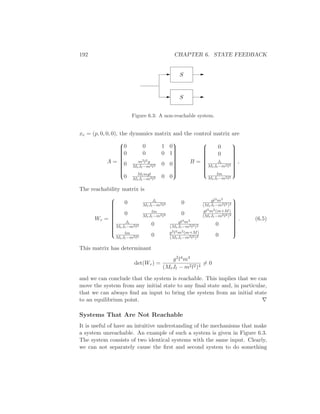




















![6.6. FURTHER READING 213
To choose specific values for the cost function weights Qx and Qu, we
must use our knowledge of the system we are trying to control. A particu-
larly simple choice of weights is to use diagonal weights
Qx =
q1 0 · · ·
...
0 · · · qn
Qu = ρ
r1 0 · · ·
...
· · · 0 rn
.
For this choice of Qx and Qu, the individual diagonal elements describe how
much each state and input (squared) should contribute to the overall cost.
Hence, we can take states that should remain very small and attach higher
weight values to them. Similarly, we can penalize an input versus the states
and other inputs through choice of the corresponding input weight.
6.6 Further Reading
The importance of state models and state feedback was discussed in the
seminal paper by Kalman [Kal60] where the state feedback gain was obtained
by solving an optimization problem that minimized a quadratic loss function.
The notions of reachability and observability (next chapter) are also due to
Kalman [Kal61b];see also [Gil63, KHN63]. We note that in most textbooks
the term “controllability” is used instead of “reachability”, but we prefer
the latter term because it is more descriptive of the fundamental property
of being able to reach arbitrary states.
Most undergraduate textbooks on control will contain material on state
space systems, including, for example, Franklin, Powell and Emami-Naeini [FPEN05]
and Ogata [Oga01]. Friedland’s textbook [Fri04] covers the material in the
previous, current and next chapter in considerable detail, including the topic
of optimal control.
6.7 Exercises
1. Consider the system shown in Figure 6.3. Write the dynamics of the
two systems as
dx
dt
= Ax + Bu
dz
dt
= Az + Bu.](https://image.slidesharecdn.com/am06-complete16sep06-150528145340-lva1-app6892/85/Am06-complete-16-sep06-225-320.jpg)

![Chapter 7
Output Feedback
There are none.
Abstract for “Gauranteed Margins for LQG Regulators”, John Doyle, 1978 [Doy78].
In the last chapter we considered the use of state feedback to modify
the dynamics of a system through feedback. In many applications, it is not
practical to measure all of the states directly and we can measure only a
small number of outputs (corresponding to the sensors that are available).
In this chapter we show how to use output feedback to modify the dynamics
of the system, through the use of observers (also called “state estimators”).
We introduce the concept of observability and show that if a system is
observable, it is possible to recover the state from measurements of the
inputs and outputs to the system.
7.1 Observability
In Section 6.2 of the previous chapter it was shown that it is possible to
find a feedback that gives desired closed loop eigenvalues provided that the
system is reachable and that all states are measured. For many situations,
it is highly unrealistic to assume that all states are measured. In this section
we will investigate how the state can be estimated by using a mathematical
model and a few measurements. It will be shown that the computation of
the states can be done by a dynamical system called an observer.
Consider a system described by
dx
dt
= Ax + Bu
y = Cx + Du,
(7.1)
215](https://image.slidesharecdn.com/am06-complete16sep06-150528145340-lva1-app6892/85/Am06-complete-16-sep06-227-320.jpg)
![216 CHAPTER 7. OUTPUT FEEDBACK
Σ
Process
n
ˆxy
Observer
˙x = Ax + Bu
y = Cx + Du
u
Figure 7.1: Block diagram for an observer.
where x ∈ Rn is the state, u ∈ R the input, and y ∈ R the measured output.
We wish to estimate the state of the system from its inputs and outputs, as
illustrated in Figure 7.1. We assume that there is only one measured signal,
i.e. that the signal y is a scalar and that C is a (row) vector. This signal
may be corrupted by noise, n, although we shall start by considering the
noise-free case. We write ˆx for the state estimate given by the observer.
Definition 7.1 (Observability). A linear system is observable if for any
T > 0 it is possible to determine the state of the system x(T) through
measurements of y(t) and u(t) on the interval [0, T].
The problem of observability is one that has many important applica-
tions, even outside of feedback systems. If a system is observable, then there
are no “hidden” dynamics inside it; we can understand everything that is
going on through observation (over time) of the inputs and outputs. As
we shall see, the problem of observability is of significant practical interest
because it will tell if a set of sensors are sufficient for controlling a system.
Sensors combined with a mathematical model can also be viewed as a “vir-
tual sensor” that gives information about variables that are not measured
directly. The definition above holds for nonlinear systems as well, and the
results discussed here have extensions to the nonlinear case.
When discussing reachability in the last chapter we neglected the output
and focused on the state. Similarly, it is convenient here to initially neglect
the input and focus on the system
dx
dt
= Ax
y = Cx.
(7.2)
We wish to understand when it is possible to determine the state from
observations of the output.](https://image.slidesharecdn.com/am06-complete16sep06-150528145340-lva1-app6892/85/Am06-complete-16-sep06-228-320.jpg)
![7.1. OBSERVABILITY 217
The output itself gives the projection of the state on vectors that are
rows of the matrix C. The observability problem can immediately be solved
if the matrix C is invertible. If the matrix is not invertible we can take
derivatives of the output to obtain
dy
dt
= C
dx
dt
= CAx.
From the derivative of the output we thus get the projection of the state on
vectors which are rows of the matrix CA. Proceeding in this way we get
y
˙y
¨y
...
y(n−1)
=
C
CA
CA2
...
CAn−1
x. (7.3)
We thus find that the state can be determined if the matrix
Wo =
C
CA
CA2
...
CAn−1
(7.4)
has n independent rows. It turns out that we need not consider any deriva-
tives higher than n − 1 (this is an application of the Cayley-Hamilton theo-
rem [Str88]).
The calculation can easily be extended to systems with inputs. The state
is then given by a linear combination of inputs and outputs and their higher
derivatives. We leave this as an exercise for the reader.
In practice, differentiation can give very large errors when there is mea-
surement noise and therefore the method sketched above is not particularly
practical. We will address this issue in more detail in the next section, but
for now we have the following basic result:
Theorem 7.1. A linear system of the form (7.1) is observable if and only
if the observability matrix Wo is full rank.
Proof. The sufficiency of the observability rank condition follows from the
analysis above. To prove necessity, suppose that the system is observable](https://image.slidesharecdn.com/am06-complete16sep06-150528145340-lva1-app6892/85/Am06-complete-16-sep06-229-320.jpg)





















![7.6. FURTHER READING 239
S¯ro and that the output is influenced by Sro and S¯ro. The system S¯r¯o is
neither connected to the input nor the output. The frequency response of
the system is thus
G(s) = C1(sI − A11)−1
B1, (7.28)
which is the dynamics of the reachable and observable subsystem Sro.
7.6 Further Reading
The notion of observability is due to Kalman [Kal61b] and, combined with
the dual notion of reachability, it was a major stepping stone toward estab-
lishing state space control theory beginning in the 1960s. For linear systems
the output is a projection of the state and it may seem unnecessary to esti-
mate the full state since a projection is already available. Luenberger [Lue71]
constructed an reduced order observer that only reconstructs the state that
is not measured directly.
The main result of this chapter is the general controller structure in Fig-
ure 7.6. This controller structure emerged as a result of solving optimization
problems. The observer first appeared as the Kalman filter which was also
the solution to an optimization problem [Kal61a, KB61]. It was then shown
that the solution to an optimization with output feedback could be obtained
by combining a state feedback with a Kalman filter [JT61, GF71]. Later
it was found that the controller with the same structure also emerged as
solutions of other simpler deterministic control problems like the ones dis-
cussed in this chapter [?, ?]. Much later it was shown that solutions to
robust control problems also had a similar structure but with different ways
of computing observer and state feedback gains [DGKF89]. The material is
now an essential part of the tools in control.
A more detailed presentation of stochastic control theory is given in [˚Ast70].
7.7 Exercises
1. Show that the system depicted in Figure 7.2 is not observable.
2. Consider a system under a coordinate transformation z = Tx, where
T ∈ Rn×n is an invertible matrix. Show that the observability ma-
trix for the transformed system is given by ˜Wo = WoT−1 and hence
observability is independent of the choice of coordinates.](https://image.slidesharecdn.com/am06-complete16sep06-150528145340-lva1-app6892/85/Am06-complete-16-sep06-251-320.jpg)

![Chapter 8
Transfer Functions
The typical regulator system can frequently be described, in essentials, by
differential equations of no more than perhaps the second, third or fourth
order. . . . In contrast, the order of the set of differential equations describing
the typical negative feedback amplifier used in telephony is likely to be very
much greater. As a matter of idle curiosity, I once counted to find out what
the order of the set of equations in an amplifier I had just designed would
have been, if I had worked with the differential equations directly. It turned
out to be 55.
Henrik Bode, 1960 [Bod60].
This chapter introduces the concept of the transfer function, which is a
compact description of the input/output relation for a linear system. Com-
bining transfer functions with block diagrams gives a powerful method for
dealing with complex linear systems. The relationship between transfer
functions and other system descriptions of dynamics is also discussed.
8.1 Frequency Domain Analysis
Figure 8.1 shows a block diagram for a typical control system, consisting of a
process to be controlled and a (dynamic) compensator, connected in a feed-
back loop. We saw in the previous two chapters how to analyze and design
such systems using state space descriptions of the blocks. As was mentioned
in Chapter 2, an alternative approach is to focus on the input/output char-
acteristics of the system. Since it is the inputs and outputs that are used to
connect the systems, one could expect that this point of view would allow
an understanding of the overall behavior of the system. Transfer functions
are the main tool in implementing this point of view for linear systems.
241](https://image.slidesharecdn.com/am06-complete16sep06-150528145340-lva1-app6892/85/Am06-complete-16-sep06-253-320.jpg)
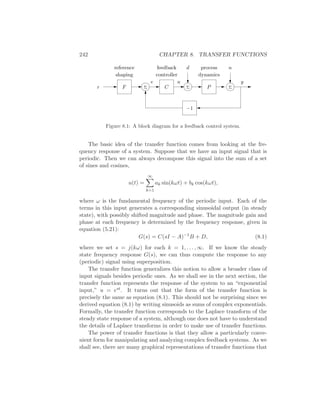
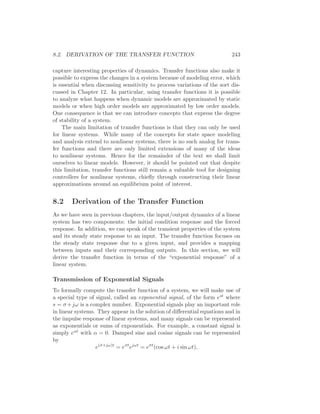





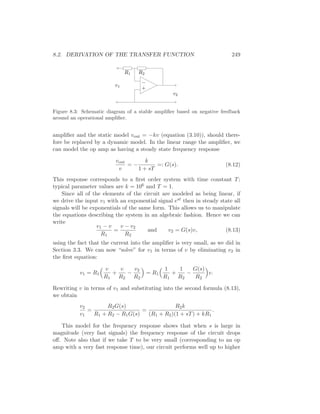


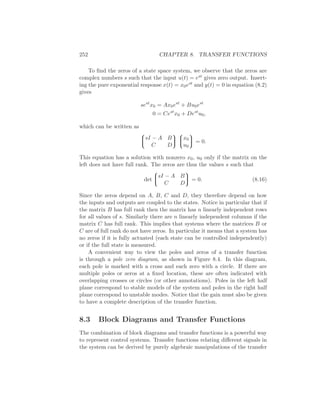






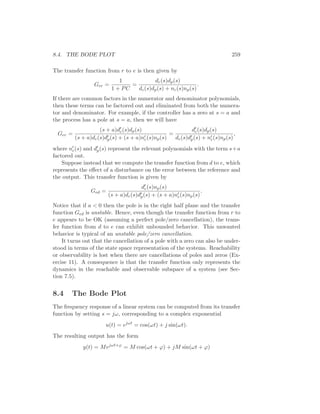
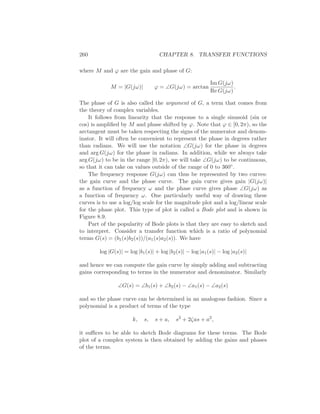





![266 CHAPTER 8. TRANSFER FUNCTIONS
10
2
10
3
10
4
10
0
10
1
10
2
10
3
10
4
−270
−180
−90
0
GainPhase
Frequency [Hz]
Figure 8.13: Frequency response of a piezoelectric drive for an atomic force micro-
scope. The input is the voltage to the drive amplifier and the output is the output
of the amplifier that measures beam deflection.
introduced in Section 3.5. Experimental determination of the frequency re-
sponse is particularly attractive for this system because its dynamics are
very fast and hence experiments can be done quickly. A typical example is
given in Figure 8.13, which shows an experimentally determined frequency
response (solid line). In this case the frequency response was obtained in
less than a second. The transfer function
G(s) =
kω2
2ω2
3ω2
5(s2 + 2ζ1ω1s + ω2
1)(s2 + 2ζ4ω4s + ω2
4)e−sT
ω2
1ω2
4(s2 + 2ζ2ω2s + ω2
2)(s2 + 2ζ3ω3s + ω2
3)(s2 + 2ζ5ω5s + ω2
5)
with ω1 = 2420, ζ1 = 0.03, ω2 = 2550, ζ2 = 0.03, ω3 = 6450, ζ3 = 0.042,
ω4 = 8250, ζ4 = 0.025, ω5 = 9300, ζ5 = 0.032, T = 10−4, and k = 5. was
fit to the data (dashed line). The frequencies associated with the zeros are
located where the gain curve has minima and the frequencies associated with
the poles are located where the gain curve has local maxima. The relative
damping are adjusted to give a good fit to maxima and minima. When a
good fit to the gain curve is obtained the time delay is adjusted to give a
good fit to the phase curve. ∇
Experimental determination of frequency response is less attractive for
systems with slow dynamics because the experiment takes a long time.
Example 8.7 (Pupillary light reflex dynamics). The human eye is an organ
that is easily accessible for experiments. It has a control system that adjusts](https://image.slidesharecdn.com/am06-complete16sep06-150528145340-lva1-app6892/85/Am06-complete-16-sep06-278-320.jpg)
![8.5. TRANSFER FUNCTIONS FROM EXPERIMENTS 267
Figure 8.14: Light stimulation of the eye. In A the light beam is so large that
it always covers the whole pupil, giving the closed loop dynamics. In B the light
is focused into a beam which is so narrow that it is not influenced by the pupil
opening, giving the open loop dynamics. In C the light beam is focused on the
edge of the pupil opening, which has the effect of increasing the gain of the system
since small changes in the pupil opening have a large effect on the amount of light
entering the eye. From [Sta59].
the pupil opening to regulate the light intensity at the retina. This control
system was explored extensively by Stark in the late 1960s [Sta68]. To de-
termine the dynamics, light intensity on the eye was varied sinusoidally and
the pupil opening was measured. A fundamental difficulty is that the closed
loop system is insensitive to internal system parameters, so analysis of a
closed loop system thus gives little information about the internal proper-
ties of the system. Stark used a clever experimental technique that allowed
him to investigate both open and closed loop dynamics. He excited the
system by varying the intensity of a light beam focused on the eye and he
measured pupil area; see Figure 8.14. By using a wide light beam that covers
the whole pupil the measurement gives the closed loop dynamics. The open
loop dynamics were obtained by using a narrow beam, which is small enough
that it is not influenced by the pupil opening. The result of one experiment
for determining open loop dynamics is given in Figure 8.15. Fitting a trans-
fer function to the gain curves gives a good fit for G(s) = 0.17/(1 + 0.08s)3.
This curve gives a poor fit to the phase curve as shown by the dashed curve
in Figure 8.15. The fit to the phase curve is improved by adding a time
delay, which leaves the gain curve unchanged while substantially modifying
the phase curve. The final fit gives the model
G(s) =
0.17
(1 + 0.08)3
e−0.2s
.
The Bode plot of this is shown with dashed curves in Figure 8.15. ∇
Notice that for both the AFM drive and the pupillary dynamics it is
not easy to derive appropriate models from first principles. In practice, it is](https://image.slidesharecdn.com/am06-complete16sep06-150528145340-lva1-app6892/85/Am06-complete-16-sep06-279-320.jpg)
![268 CHAPTER 8. TRANSFER FUNCTIONS
2 5 10 20
0.01
0.02
0.05
0.1
0.2
2 5 10 20
−360
−180
0
ω
|G(jω)|∠G(jω)
Figure 8.15: Sample curves from open loop frequency response of the eye (left) and
Bode plot for the open loop dynamics (right). Redrawn from the data of [Sta59].
The dashed curve in the Bode plot is the minimum phase curve corresponding to
the gain curve.
often fruitful to use a combination of analytical modeling and experimental
identification of parameters.
8.6 Laplace Transforms
Transfer functions are typically introduced using Laplace transforms and in
this section we derive the transfer function using this formalism. We assume
basic familiarity with Laplace transforms; students who are not familiar with
them can safely skip this section.
Traditionally, Laplace transforms were also used to compute responses
of linear system to different stimuli. Today we can easily generate the re-
sponses using computers. Only a few elementary properties are needed for
basic control applications. There is, however, a beautiful theory for Laplace
transforms that makes it possible to use many powerful tools of the theory
of functions of a complex variable to get deep insights into the behavior of
systems.
Definitions and Properties
Consider a time function f : R+ → R which is integrable and grows no faster
than es0t for some finite s0 ∈ R and large t. The Laplace transform maps f](https://image.slidesharecdn.com/am06-complete16sep06-150528145340-lva1-app6892/85/Am06-complete-16-sep06-280-320.jpg)


![8.7. FURTHER READING 271
Elimination of X(s) gives
Y (s) = C(sI − A)−1
B + D U(s). (8.24)
The transfer function is thus G(s) = C(sI − A)−1B + D (compare with
equation (8.4)).
The formula (8.24) has a strong intuitive interpretation because it tells
that the Laplace transform of the output is the product of the transfer
function of the system and the transform of the input. In the transform
domain the action of a linear system on the input is simply a multiplication
with the transfer function. The transfer function is a natural generalization
of the concept of gain of a system.
8.7 Further Reading
Heaviside, who introduced the idea to characterize dynamics by the response
to a unit step function, also introduced a formal operator calculus for an-
alyzing linear systems. This was a significant advance because it gave
the possibility to analyze linear systems algebraically. Unfortunately it was
difficult to formalize Heaviside’s calculus properly. This was not done until
the the mathematician Laurent Schwartz developed the distribution the-
ory in the late 1940s. Schwartz was given the Fields Medal in 1950. The
idea of characterizing a linear system by its steady state response to sinu-
soids was introduced by Fourier in his investigation of heat conduction in
solids [Fou07]. Much later it was used by Steinmetz when he introduced the
jω method to develop a theory for alternating currents.
The concept of transfer functions was an important part of classical con-
trol theory; see [JNP47]. It was introduced via the Laplace transform by
Gardner Barnes [GB42], who also used it to calculate response of linear
systems. The Laplace transform was very important in the early phase of
control because it made it possible to find transients via tables. The Laplace
transform is of less importance today when responses to linear systems can
easily be generated using computers. For a mathematically inclined audi-
ence it is still a very convenient to introduce the transfer function via the
Laplace transform, which is an important part of applied mathematics. For
an audience with less background in mathematics it may be preferable to
introduce the transfer function via the particular solution generated by the
input est as was done in Section 8.2.
There are many excellent books on the use of Laplace transforms and
transfer functions for modeling and analysis of linear input/output systems.](https://image.slidesharecdn.com/am06-complete16sep06-150528145340-lva1-app6892/85/Am06-complete-16-sep06-283-320.jpg)
![272 CHAPTER 8. TRANSFER FUNCTIONS
Traditional texts on control, such as [FPEN05] and [DB04], are representa-
tive examples.
8.8 Exercises
1. Let G(s) be the transfer function for a linear system. Show that if we
apply an input u(t) = A sin(ωt) then the steady state output is given
by y(t) = |G(jω)|A sin(ωt + arg G(jω)).
2. Show that the transfer function of a system only depends on the dy-
namics in the reachable and observable subspace of the Kalman de-
composition.
3. The linearized model of the pendulum in the upright position is char-
acterized by the matrices
A =
0 1
1 0
, B =
0
1
, C =
1 0
, D = 0.
Determine the transfer function of the system.
4. Compute the frequency response of a PI controller using an op amp
with frequency response given by equation (8.12).
5. Consider the speed control system given in Example 6.9. Compute
the transfer function between the throttle position u, angle of the
road θ and the speed of the vehicle v assuming a nominal speed ve
with corresponding throttle position ue.
6. Consider the differential equation
dny
dtn
+ a1
dn−1y
dtn−1
+ a2
dn−2y
dtn−2
+ · · · + any = 0
Let λ be a root of the polynomial
sn
+ a1sn−1
+ · · · + an = 0.
Show that the differential equation has the solution y(t) = eλt.
7. Consider the system
dny
dtn
+ a1
dn−1y
dtn−1
+ · · · + any = b1
dn−1u
dtn−1
+ b2
dn−2u
dtn−2
+ · · · + bnu,](https://image.slidesharecdn.com/am06-complete16sep06-150528145340-lva1-app6892/85/Am06-complete-16-sep06-284-320.jpg)

![274 CHAPTER 8. TRANSFER FUNCTIONS
damper we have F = k(xw − xb) + c( ˙xw − ˙xb), for an active damper
the force F can be more general and it can also depend on riding
conditions. Rider comfort can be characterized by the transfer function
Gaxr from road height xr to body acceleration a = ¨xb. Show that this
transfer function has the property Gaxr (iωt) = kt/mb, where ωt =
kt/mw (the tire hop frequency). The equation implies that there are
fundamental limitations to the comfort that can be achieved with any
damper. More details are given in [HB90].
9. Damping vibrations is a common engineering problem. A schematic
diagram of a damper is shown in Figure 8.16(b). The disturbing vibra-
tion is a sinusoidal force acting on mass m1 and the damper consists
of mass m2 and the spring k2. Show that the transfer function from
disturbance force to height x1 of the mass m1 is
Gx1F =
m2s2 + k2
m1m2s4 + m2c1s3 + (m1k2 + m2(k1 + k2))s2 + k2c1s + k1k2
How should the mass m2 and the stiffness k2 be chosen to eliminate
a sinusoidal oscillation with frequency ω0. More details are given on
pages 87–93 in the classic text on vibrations [DH85].
10. Consider the linear state space system
˙x = Ax + Bu
y = Cx.
Show that the transfer function is
G(s) =
b1sn−1 + b2sn−2 + · · · + bn
sn + a1sn−1 + · · · + an
where
b1 = CB
b2 = CAB + a1CB
b3 = CA2
B + a1CAB + a2CB
...
bn = CAn−1
B + a1CAn−1
B + · · · + an−1CB
and λ(s) = sn + a1sn−1 + · · · + an is the characteristic polynomial for
A.](https://image.slidesharecdn.com/am06-complete16sep06-150528145340-lva1-app6892/85/Am06-complete-16-sep06-286-320.jpg)
![8.8. EXERCISES 275
11. Consider a closed loop system of the form of Figure 8.6 with F = 1 and
P and C having a common pole. Show that if each system is written
in state space form, the resulting closed loop system is not reachable
and not observable.
12. The Physicist ˚Angstr¨om, who is associated with the length unit ˚A,
used frequency response to determine thermal diffusivity of metals [˚Ang61].
Heat propagation in a metal rod is described by the partial differential
equation
∂T
∂t
= a
∂2T
∂x2
− µT, (8.25)
where a = λ
ρC is the thermal diffusivity, and the last term represents
thermal loss to the environment. Show that the transfer function re-
lating temperatures at points with the distance ℓ is
G(s) = e−ℓ
√
(s+µ)/a
, (8.26)
and the frequency response is given by
log |G(iω)| = −ℓ
µ + ω2 + µ2
2a
arg G(iω) = −ℓ
−µ + ω2 + µ2
2a
.
Also derive the following equation
log |G(iω)| arg G(iω) =
ℓ2ω
2a
.
This remarkably simple formula shows that diffusivity can be deter-
mined from the value of the transfer function at one frequency. It was
the key in ˚Angstr¨om’s method for determining thermal diffusivity. No-
tice that the parameter µ which represents the thermal losses does not
appear in the formula.](https://image.slidesharecdn.com/am06-complete16sep06-150528145340-lva1-app6892/85/Am06-complete-16-sep06-287-320.jpg)

![Chapter 9
Loop Analysis
Regeneration or feed-back is of considerable importance in many applications
of vacuum tubes. The most obvious example is that of vacuum tube oscil-
lators, where the feed-back is carried beyond the singing point. Another ap-
plication is the 21-circuit test of balance, in which the current due to the
unbalance between two impedances is fed back, the gain being increased until
singing occurs. Still other applications are cases where portions of the output
current of amplifiers are fed back to the input either unintentionally or by de-
sign. For the purpose of investigating the stability of such devices they may
be looked on as amplifiers whose output is connected to the input through a
transducer. This paper deals with the theory of stability of such systems.
Abstract for “Regeneration Theory”, Harry Nyquist, 1932 [Nyq32].
In this chapter we study how how stability and robustness of closed loop
systems can be determined by investigating how signals propagate around
the feedback loop. The Nyquist stability theorem is a key result that pro-
vides a way to analyze stability and introduce measures of degrees of stabil-
ity.
9.1 The Loop Transfer Function
The basic idea of loop analysis is to trace how a sinusoidal signal propagates
in the feedback loop and explore the resulting stability by investigating if
the signal grows or decays around the loop. This is easy to do because the
transmission of sinusoidal signals through a (linear) dynamical system is
characterized by the frequency response of the system. The key result is the
Nyquist stability theorem, which provides a great deal of insight regarding
the stability of a system. Unlike proving stability with Lyapunov functions,
277](https://image.slidesharecdn.com/am06-complete16sep06-150528145340-lva1-app6892/85/Am06-complete-16-sep06-289-320.jpg)





![9.2. THE NYQUIST CRITERION 283
Re L(jω)
Im L(jω)
1
Figure 9.4: Nyquist plot of the transfer function L(s) = e−
√
s
Nyquist’s Stability Theorem
We will now state and prove the Nyquist stability theorem for a general loop
transfer function L(s). This requires some results from the theory of complex
variables, for which the reader can consult [?] and the references therein.
Since some precision is needed in stating Nyquist’s criterion properly, we
will also use a more mathematical style of presentation. The key result is
the following theorem about functions of complex variables.
Theorem 9.2 (Principle of variation of the argument). Let D be a closed
region in the complex plane and let Γ be the boundary of the region. Assume
the function f : C → C is analytic in D and on Γ, except at a finite number
of poles and zeros. Then the winding number, wn, is given by
wn =
1
2π
∆Γ arg f(z) =
1
2πi Γ
f′(z)
f(z)
dz = N − P,
where ∆Γ is the net variation in the angle along the contour Γ, N is the
number of zeros and P the number of poles in D. Poles and zeros of multi-
plicity m are counted m times.
Proof. Assume that z = a is a zero of multiplicity m. In the neighborhood
of z = a we have
f(z) = (z − a)m
g(z),](https://image.slidesharecdn.com/am06-complete16sep06-150528145340-lva1-app6892/85/Am06-complete-16-sep06-295-320.jpg)









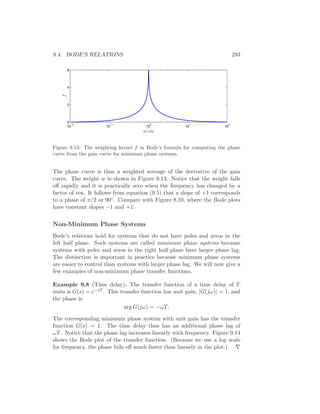





![9.6. FURTHER READING 299
Notice that if systems H1 and H2 are linear it follows from the Nyquist
stability theorem that the closed loop is stable, because if γ1γ2 < 1 the
Nyquist curve is always inside the unit circle. The small gain theorem is
thus an extension of the Nyquist stability theorem.
It also follows from the Nyquist stability theorem that a closed loop
system is stable if the phase of the loop transfer function is between −π and
π. This result can also be extended to nonlinear systems as well. It is called
the passivity theorem and is closely related to the small gain theorem.
Additional applications of the small gain theorem and its application to
robust stability are given in Chapter 12.
9.6 Further Reading
Nyquist’s original paper giving his now famous stability criterion was pub-
lished in the Bell Systems Technical Journal in 1932 [Nyq32].
9.7 Exercises
1. Use the Nyquist theorem to analyze the stability of the speed con-
trol system in Example 9.1, but using the original PI controller from
Example 6.9.
2. Discrete time Nyquist
3. Example systems:](https://image.slidesharecdn.com/am06-complete16sep06-150528145340-lva1-app6892/85/Am06-complete-16-sep06-311-320.jpg)

![Chapter 10
PID Control
Based on a survey of over eleven thousand controllers in the refining, chemi-
cals and pulp and paper industries, 97% of regulatory controllers utilize PID
feedback.
Desborough Honeywell, 2000, see [DM02].
PID control is by far the most common way of using feedback in natural
and man-made systems. PID controllers are commonly used in industry
and a large factory may have thousands of them, in instruments and lab-
oratory equipment. In engineering applications the controllers appear in
many different forms: as a stand alone controller, as part of hierarchical,
distributed control systems, or built into embedded components. Most con-
trollers do not use derivative action. In this chapter we discuss the basic
ideas of PID control and the methods for choosing the parameters of the
controllers. Many aspects of control can be understood based on linear
analysis. However, there is one nonlinear effect, that has to be considered in
most control systems namely that actuators saturate. In combinations with
controllers having integral actions saturations give rise to an effect called
integral windup. This phenomenon that occurs in practically all control
systems will be discussed in depth for PID controllers. Methods to avoid
windup will also be presented. Finally we will also discuss implementation
of PID controllers, similar methods can be used to implement many other
controllers.
301](https://image.slidesharecdn.com/am06-complete16sep06-150528145340-lva1-app6892/85/Am06-complete-16-sep06-313-320.jpg)










![312 CHAPTER 10. PID CONTROL
0 10 20 30 40
−1.5
−1
−0.5
0
0 10 20 30 40
0
0.2
0.4
0.6
0.8
throttle
t [s]
v[m/s]
0 10 20 30 40
−1
−0.5
0
0.5
0 10 20 30 40
0
0.2
0.4
0.6
0.8
throttle
t [s]
v[m/s]
Figure 10.6: Illustrates the effect of parameters ω0 (left) and ζ0 (right) on the
response of a car with cruise control.
The consequences of different choices of ω0 and ζ0 are illustrated in
Figure 10.6. The figure shows the velocity and throttle for a car that first
moves on a horizontal road and encounters a hill with slope 4◦ at time 6.
Between time 5 and 6 the slope increases linearly. The choice of ω0 is a
compromise between response speed and control actions. The compromise
is illustrated in Figure 10.6, which shows the velocity error and the control
signal for a simulation where the slope of the road suddenly changes by 4◦.
The largest velocity error decreases with increasing ω0, but the control signal
also changes more rapidly. In the simple model (10.10) it was assumed that
the force responds instantaneously to throttle commands. For rapid changes
there may be additional dynamics that has to be accounted for. There are
also physical limitations to the rate of change of the force, which also restrict
the admissible value of ω0. A reasonable choice of ω0 is in the range of 0.2
to 1.0. Notice in Figure 10.6 that even with ω0 = 0.1 the largest velocity
error is only 1 m/s.
Another interpretation of the effect of the integral action can be given
by returning to the basic force balance model of the car
m
dv
dt
= F − Fd,
where m is the mass of the car, F is the applied force (from the engine)
and Fd is the disturbance force (aerodynamic drag and force of gravity).
Since zero steady state error implies that v is constant, we see that the PI
controller generates an output force F that in steady state is equal to the](https://image.slidesharecdn.com/am06-complete16sep06-150528145340-lva1-app6892/85/Am06-complete-16-sep06-324-320.jpg)

![314 CHAPTER 10. PID CONTROL
0 20 40 60
18
19
20
21
0 20 40 60
0
0.5
1
1.5
2
2.5
Velocity[m/s]Throttle
Time [s]
(a)
0 20 40 60
18
19
20
21
0 20 40 60
0
0.5
1
1.5
2
2.5
Velocity[m/s]Throttle
Time [s]
(b)
Figure 10.7: Simulation of windup (left) and anti-windup (right). The figure shows
the speed v and the throttle u for a car that encounters a slope that is so steep that
the throttle saturates. The controller output is dashed. The controller parameters
are kp = 0.5 and ki = 0.1.
Avoiding Windup
There are many ways to avoid windup. One method is illustrated in Fig-
ure 10.8: the system has an extra feedback path that is generated by mea-
suring the actual actuator output, or the output of a mathematical model
of the saturating actuator, and forming an error signal (es) as the difference
between the output of the controller (v) and the actuator output (u). The
signal es is fed to the input of the integrator through gain kt. The signal
es is zero when there is no saturation and the extra feedback loop has no
effect on the system. When the actuator saturates, the signal es is feedback
to the integrator in such a way that es goes towards zero. This implies that
controller output is kept close to the saturation limit. The controller output
will then change as soon as the error changes sign and integral windup is
avoided.
The rate at which the controller output is reset is governed by the feed-
back gain, kt, a large value of kt give a short reset time. The parameter kt
can, however, not be too large because measurement error can then cause
an undesirable reset. A reasonable compromise is to choose kt ≈ 1/Ti for PI
control and as kt ≈ 1/
√
TiTd for PID control. We illustrate how integral
windup can be avoided by investigating the cruise control system.
Example 10.3 (Cruise control). Figure 10.7b shows what happens when](https://image.slidesharecdn.com/am06-complete16sep06-150528145340-lva1-app6892/85/Am06-complete-16-sep06-326-320.jpg)




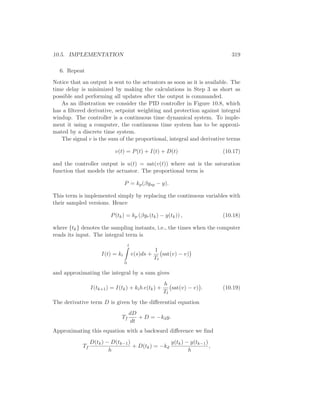

![10.7. EXERCISES 321
given by Mindel [Min02]. A comprehensive presentation of PID control is
given in [˚AH95].
10.7 Exercises
1. Consider a second order process with transfer function
P(s) =
b
s2 + a1s + a2
.
Find the gains for a PID controller that gives the closed loop system
a characteristic polynomial of the form
s2
+ 2ζω0s + ω2
0.
2. (Vehicle steering) Design a proportion-integral controller for the vehi-
cle steering system that gives closed loop characteristic equation
s3
+ 2ω0s2
+ 2ω0s + ω3
0.](https://image.slidesharecdn.com/am06-complete16sep06-150528145340-lva1-app6892/85/Am06-complete-16-sep06-333-320.jpg)









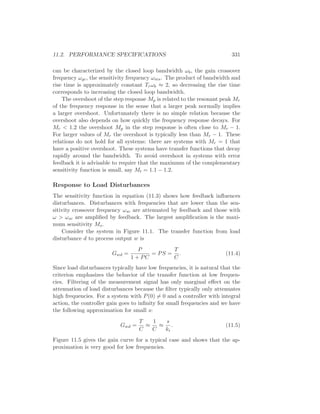



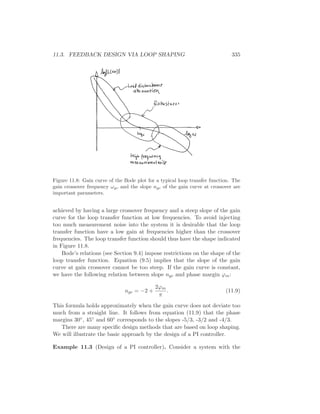









![11.5. DESIGN EXAMPLE 345
phase-margin that can be achieved for a given ratio p/z is
ϕm < π + ngc
π
2
− 4 arctan
p
z
. (11.20)
A pair of poles and zeros in the right half plane thus imposes severe con-
straints on the gain crossover frequency. The best gain crossover frequency
is the geometric mean of the unstable pole and zero. A robust controller
does not exist unless the pole/zero ratio is sufficiently small. ∇
Avoiding Difficulties with RHP Poles and Zeros
As the examples above show, right half plane poles and zeros significantly
limit the achievable performance of a system, hence one would like to avoid
these whenever possible. The poles of a system depend on the intrinsic
dynamics of the system and are given by the eigenvalues of the dynamics
matrix A of a linear system. Sensors and actuators have no effect on the
poles. The only way to change poles is to redesign the system. Notice
that this does not imply that unstable systems should be avoided. Unstable
system may actually have advantages; one example is high performance
supersonic aircraft.
The zeros of a system depend on the how sensors and actuators are
coupled to the states. The zeros depend on all the matrices A, B, C and D
in a linear system. The zeros can thus be influenced by moving sensors and
actuators or by adding sensors and actuators. Notice that a fully actuated
system B = I does not have any zeros.
11.5 Design Example
In this section we carry out a detailed design example that illustrates the
main techniques in this chapter.
11.6 Further Reading
A more complete description of the material in this chapter is available in
the text by Doyle, Frances and Tannenbaum [DFT92] (out of print, but
available online).](https://image.slidesharecdn.com/am06-complete16sep06-150528145340-lva1-app6892/85/Am06-complete-16-sep06-357-320.jpg)

![Chapter 12
Robust Performance
However, by building an amplifier whose gain is deliberately made, say 40
decibels higher than necessary (10000 fold excess on energy basis), and then
feeding the output back on the input in such a way as to throw away that
excess gain, it has been found that extraordinary improvements in constancy
of amplification and freedom from non-linearity.
Harold S. Black, “Stabilized Feedback Amplifiers”, 1934 [Bla34].
The above quote illustrates that one the key uses of feedback is to pro-
vide robustness to uncertainty. It is one of the most useful properties of
feedback and is what makes it possible to design feedback systems based
on strongly simplified models. This chapter focuses on the analysis of ro-
bustness of feedback systems. We consider the stability and performance of
systems who process dynamics are uncertain and derive fundamental limits
for robust stability and performance. To do this we develop ways to model
uncertainty, both in the form of parameter variations and in the form of
neglected dynamics. We also discuss how to design controllers to achieve
robust performance. One limitation of the tools we present here is that they
are usually restricted to linear systems, although some nonlinear extensions
have been developed.
12.1 Modeling Uncertainty
One form of uncertainty in dynamical systems is that the parameters de-
scribing the system are unknown, which is called parametric uncertainty. A
typical example is the variation of the mass of a car, which changes with
the number of passengers and the weight of the baggage. When linearizing
a nonlinear system, the parameters of the linearized model also depend on
347](https://image.slidesharecdn.com/am06-complete16sep06-150528145340-lva1-app6892/85/Am06-complete-16-sep06-359-320.jpg)



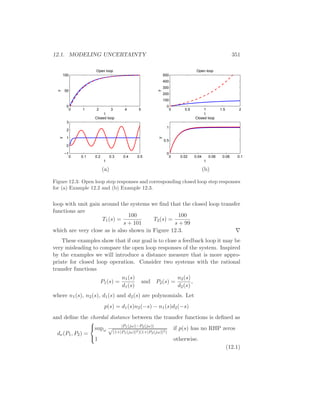
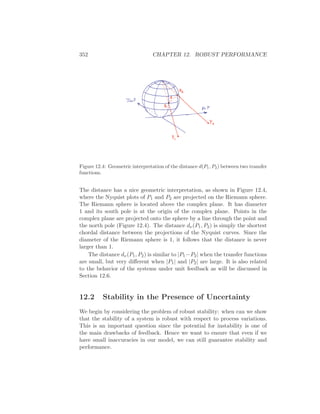























![376 CHAPTER 12. ROBUST PERFORMANCE
Robustness
There are strong robustness results associated with the H∞ controller. We
can understand this intuitively by comparing Equations (12.1) and (12.18).
We can then conclude that
H(P, C) ∞ =
1
d(P, −1/C)
(12.20)
The inverse of H(P, C) ∞ is thus equal to chordal distance between P and
1/C. If we find a controller C with H(P, C) ∞ < γ this controller will
then stabilize any process P∗ such that d(P, P∗) < γ.
Limits of Robust Design
There is a limit to what can be achieved by robust design. In spite of the nice
properties of feedback there are situations where the process variations are
so large that it is not possible to find a linear controller which gives a robust
system with good performance. It is then necessary to use other controllers.
In some cases it is possible to measure a variable that is well correlated
with the process variations. Controllers for different parameters values can
then be designed and the corresponding controller can be chosen based on
the measured signal. This type of controller is called gain scheduling. The
cruise controller is a typical example where the measured signal could be
gear position and velocity. Gain scheduling is the common solution for high
performance aircraft where scheduling is done based on Mach number and
dynamic pressure. When using gain scheduling it is important to make sure
that switches between the controllers do not create undesirable transients.
If it is not possible to measure variables related to the parameters, it is
possible to use automatic tuning and adaptive control. In automatic tuning
process dynamics is measured by perturbing the system and a controller
is then designed automatically. Automatic tuning requires that parameters
remain constant, it has been widely applied for PID control, it is a reasonable
guess that, in the future, many controllers will have features for automatic
tuning. If parameters are changing it is possible to use adaptive methods
where where process dynamics is measured on-line.
12.7 Further Reading
Robustness was a central issue in classical control, see [Bod45]. It was
deemphasized in the euphoria of the development of design methods based](https://image.slidesharecdn.com/am06-complete16sep06-150528145340-lva1-app6892/85/Am06-complete-16-sep06-388-320.jpg)
![12.8. EXERCISES 377
on optimization. The strong robustness of LQ control based on state feed-
back shown by Anderson and Moore [?] contributed to the optimism. The
poor robustness of output feedback based on LQG was pointed out by Rosen-
brock [RM71], Horowitz [Hor75] and Doyle [Doy78] resulted in a renewed
interest in robustness. A major step forward was the development of design
methods where robustness was explicitly taken into account. Seminal work
by Zames [Zam81] was a major step forward. Robust control was origi-
nally developed using powerful results from the theory of complex variables
which unfortunately gave controllers of very high order. A major break
through was given by Doyle, Glover, Khargonekar, and Francis [DGKF89]
who showed that the solution could be obtained using Riccati equations and
that a controller of low order could be found. This paper led to an exten-
sive treatment of the so-called H∞ control [Fra87, MG90, DFT92, GL95,
ZDG96, SP96, Vin01]. A major advantage of the theory is that it combines
much of the intuition from servomechanism theory with sound numerical
algorithms based on numerical linear algebra and optimization. The results
have been extended to nonlinear systems by treating the design problem as
a game where the disturbances are generated by an adversary as described
in [BB91]. Auto-tuning and adaptive control are treated in [˚AW95] and
automatic tuning is dealt with in depth in [˚AH05].
12.8 Exercises
1. Show that an additive disturbance δadd, show that it can create RHP
zeros, but not RHP poles, and that a feedback disturbance δfbk can
create RHP poles but not RHP zeros. Also give constructive examples.
2. Compute the distance between the systems
P1(s) =
k
s + 1
, andP2(s) =
k
s − 11
.
for k = 1, 2 and 5.
3. The distance measure is closely related to closed loop systems with
unit feedback. Show how the measure can be modified to applied to
an arbitrary feedback.
4. Consider the Nyquist curve in Figure 12.12. Explain why part of the
curve is approximately a circle. Derive a formula for the center and
the radius and compare with the actual Nyquist curve.](https://image.slidesharecdn.com/am06-complete16sep06-150528145340-lva1-app6892/85/Am06-complete-16-sep06-389-320.jpg)

![Bibliography
[Abk69] M. A. Abkowitz. Stability and Motion Control of Ocean Vehicles. MIT
Press, Cambridge, MA, 1969.
[˚AH95] K. J. ˚Astr¨om and T. H¨agglund. PID Controllers; Theory, Design and
Tuning. Instrument Society of American, 1995.
[˚AH05] Karl Johan ˚Astr¨om and Tore H¨agglund. Advanced PID Control. ISA
- The Instrumentation, Systems, and Automation Society, Research
Triangle Park, NC 27709, 2005.
[˚AKL05] K. J. ˚Astr¨om, R. E. Klein, and A. Lennartsson. Bicycle dynamics and
control. IEEE Control Systems Magazine, 25(4):26–47, 2005.
[˚Ang61] A. I. ˚Angstr¨om. Neue Methode, das v¨armeleitungsverm¨ogen der K¨orper
zu bestimmen. Ann. der Physik und Chemie, 114:513–530, 1861.
[˚Ast70] K. J. ˚Astr¨om. Introduction to Stochastic Control Theory. Academic
Press, 1970. Republished by Dover Publications, 2006.
[˚AW95] K. J. ˚Astr¨om and B. Wittenmark. Adaptive Control. Addison-Wesley,
Reading, Massachusetts, second edition, 1995.
[B˚A70] R. Bellman and K. J. ˚Astr¨om. On structural identifiability. Mathemat-
ical Biosciences, 7:329–339, 1970.
[BB91] T. Basar and P. Bernhard. H∞
-Optimal control and related minimax
design problems - A Dynamic game approach. Birkhauser, Boston, 1991.
[Bec05] J. Bechhoefer. Feedback for physicists: A tutorial essay on control.
Reviews of Modern Physics, 77:783–836, 2005.
[Ben86a] S. Bennett. A History of Control Engineering: 1800–1930. Peter Pere-
grinus, 1986.
[Ben86b] S. Bennett. A History of Control Engineering: 1930–1955. Peter Pere-
grinus, 1986.
[Ber54] L. L. Beranek. Acoustics. McGraw-Hill, New York, NY, 1954.
[BK64] R. E. Bellman and R. Kalaba. Selected Papers on Mathematical Trends
in Control Theory. Dover, New York, NY, 1964.
379](https://image.slidesharecdn.com/am06-complete16sep06-150528145340-lva1-app6892/85/Am06-complete-16-sep06-391-320.jpg)
![380 BIBLIOGRAPHY
[Bla34] H. S. Black. Stabilized feedback amplifiers. Bell System Technical Jour-
nal, 13:1–2, 1934.
[Bla91] J. H. Blakelock. Automatic Control of Aircraft and Missiles. Addison-
Wesley, Cambridge, MA, second edition, 1991.
[Bod45] H. W. Bode. Network Analaysis and Feedback Amplifier Design. Van
Nostrand, 1945.
[Bod60] H. W. Bode. Feedback—The History of an Idea. In Symposium on Ac-
tive Networks and Feedback Systems. Polytechnic Institute of Brooklyn,
1960. in [BK64].
[BP96] M. B. Barron and W. F. Powers. The role of electronic controls for future
automotive mechatronic systems. IEEE Transactions on Mechatronics,
1(1):80–89, 1996.
[Bro00] R. W. Brockett. New issues in the mathematics of control. In B. En-
gquist and W. Schmid, editors, Mathematics Unlimited—2001 and Be-
yond, pages 189–220. Springer Verlag, 2000.
[BS60] J. F. andG. Reethof Blackburn and J.L. Shearer. Fluid Power Control.
MIT Press, Cambridge, MA, 1960.
[Can03] R. H. Cannon. Dynamics of Physical Systems. Dover, originally pub-
lished by mc-graw hill 1967 edition, 2003.
[CD75] R. F. Coughlin and F. F. Driscoll. Operational Amplifiers and Linear
Integrated Circuits. 6th Edition. Prentice Hall, Englewood Cliffs, NJ,
1975.
[CD91] F. M. Callier and C. A. Desoer. Linear System Theory. Springer-Verlag,
1991.
[CJ59] H. S. Carslaw and J. C. Jaeger. Conduction of Heat in Solids. Carendon
Press, Oxford, second edition, 1959.
[DB04] R. C. Dorf and R. H. Bishop. Modern Control Systems. Prentice Hall,
tenth edition, 2004.
[DFT92] J. C. Doyle, B. A. Francis, and A. R. Tannenbaum. Feedback Control
Theory. Macmillan Publishing Company, 1992.
[DGKF89] J. C. Doyle, K. Glover, P. P. Khargonekar, and B. A. Francis. State-
space solutions to standard H2 and H∞ control problems. IEEE Trans-
actions on Automatic Control, 34(8):831–847, 1989.
[DH85] J.P. Den Hartog. Mechanical Vibrations. Dover, New York, 1985.
Reprint of fourth edition from 1956, first edition published in 1934.
[dJ02] H. de Jong. Modeling and simulation of genetic regulatory systems: A
literature review. Journal of Computational Biology, 9:67–103, 2002.](https://image.slidesharecdn.com/am06-complete16sep06-150528145340-lva1-app6892/85/Am06-complete-16-sep06-392-320.jpg)
![BIBLIOGRAPHY 381
[DM02] L. Desbourough and R. Miller. Increasing customer value of indus-
trial control performance monitoring - Honeywell’s experience. In Sixth
International Conference on Chemical Process Control. AIChE Sympo-
sium Series Number 326 (Volume 98), 2002.
[Dos68] F.H. Dost. Grundlagen der Pharmakokinetik. Thieme Verlag, Stuttgart,
1968.
[Doy78] J. C. Doyle. Guaranteed margins for lqg regulators. IEEE Transactions
on Automatic Control, 23(4):756–757, 1978.
[Dys04] F. Dyson. A meeting with enrico fermi. Nature, 247(6972):297, 2004.
[EG05] S. P. Ellner and J. Guckenheimer. Dynamic Models in Biology. Prince-
ton University Press, 2005.
[EL00] M. B. Elowitz and S. Leibler. A synthetic oscillatory network of tran-
scriptional regulators. Nature, 403(6767):335–338, 2000.
[Ell94] J. R. Ellis. Vehicle Handling Dynamics. Mechanical Engineering Pub-
lications, London, 1994.
[Fey70] R. P. Feynmann. Lectures on Physics. Addison Wesley, New York, NY,
1970.
[Fou07] J. B. J. Fourier. On the Propagation of Heat in Solid Bodies. 1807.
[FPEN05] G. F. Franklin, J. D. Powell, and A. Emami-Naeini. Feedback Control
of Dynamic Systems. Addison Wesley Longman, fifth edition, 2005.
[Fra87] B. A. Francis. A Course in H∞ Control. Springer-Verlag, Berlin, 1987.
[Fri04] B. Friedland. Control System Design: An Introduction to State Space
Methods. Dover, 2004.
[GB42] M. A. Gardner and J. L. Barnes. Transients in Linear Systems. John
Wiley, New York, 1942.
[GF71] L. Gunkel and G. F. Franklin. A general solution for linear sampled
data systems. IEEE Transactions on Automatic Control, AC-16:767–
775, 1971.
[GH83] J. Guckenheimer and P. Holmes. Nonlinear Oscillations, Dynamical
Systems, and Bifurcations of Vector Fields. Springer Verlag, 1983.
[Gil63] E. Gilbert. Controllability and observability in multivariable control
systems. SIAM J. Control, 1(1):128–151, 1963.
[GL95] Michael Green and D. J. N. Limebeer. Linear Robust Control. Prentice
Hall, Englewood Cliffs, N.J., 1995.
[God83] K. Godfrey. Compartment models and their application. Academic
Press, New York, NY, 1983.](https://image.slidesharecdn.com/am06-complete16sep06-150528145340-lva1-app6892/85/Am06-complete-16-sep06-393-320.jpg)
![382 BIBLIOGRAPHY
[Gol53] H. Goldstein. Classical Mechanics. Addison-Wesley, Cambridge, MA,
1953.
[Gol70] S. W. Golomb. Mathematical models—uses and limitations. Simulation,
4(14):197–198, 1970.
[GP82] M. Giobaldi and D. Perrier. Pharmacokinetics, Second Edition. Marcel
Dekker, New York, 1982.
[Gui63] E. A. Guillemin. Theory of Linear Physical Systems. MIT Press, Cam-
bridge, MA, 1963.
[HB90] J. K. Hedrick and T. Batsuen. Invariant properties of automobile sus-
pensions. In Proc. Institution of Mechanical Engineers, volume 204,
pages 21–27, London, UK., 1990.
[HD95] M. B. Hoagland and B. Dodson. The Way Life Works. Times Books,
1995.
[HDPT04] J. L. Hellerstein, Y. Diao, S. Parekh, and D. M. Tilbury. Feedback
Control of Computing Systems. John Wiley, New York, 2004.
[Hen06] Dan Henriksson. Resource-Constrained Embedded Control and Com-
puting Systems. PhD thesis, Department of Automatic Control, Lund
Institute of Technology, Sweden, January 2006.
[Her04] David V. Herlihy. Bicycle - The History. Yale University Press, Yale,
NH, 2004.
[HH52] A. L. Hodgkin and A. F. Huxley. A quantitative description of mem-
brane current and its application to conduction and excitation in nerve.
Journal of Physiology, 117(500–544), 1952.
[HLA04] D. Henriksson, Y. Lu, and T. Abdelzaher. Improved prediction for
web server delay control. In 16th Euromicro Conference on Real-Time
Systems, Catania, Sicily, Italia, 2004.
[Hor75] I. M. Horowitz. Superiority of transfer function over state-varible meth-
ods in linear, time-invariant feedback system design. IEEE Transactions
on Automatic Control, AC-20(1):84–97, 1975.
[HW00] D. Hanahan and R. A. Weinberg. The hallmarks of cancer. Cell, 100:57–
70, 2000.
[Isi89] A. Isidori. Nonlinear Control Systems. Springer-Verlag, 2nd edition,
1989.
[Jac72] J. A. Jacquez. Compartment analysis in biology and medicine. Elsevier,
Amsterdam, 1972.
[Jac88] V. Jacobson. Congestion avoidance and control. In Proc. SIGCOMM
’88, pages 314–329, 1988.](https://image.slidesharecdn.com/am06-complete16sep06-150528145340-lva1-app6892/85/Am06-complete-16-sep06-394-320.jpg)
![BIBLIOGRAPHY 383
[JNP47] H. James, N. Nichols, and R. Philips. Theory of Servomechanisms.
McGraw-Hill, 1947.
[JT61] P. D. Joseph and J. T. Tou. On linear control theory. Transactions of
AIEE, 80(18), 1961.
[Jun02] W. G. (editor) Jung, editor. Op Amp Applications. Analog Devices,
Norwood, MA, 2002.
[Kal60] R. E. Kalman. Contributions to the theory of optimal control. Boletin
de la Sociedad Mat´ematica Mexicana, 5:102–119, 1960.
[Kal61a] R. E. Kalman. New methods and results in linear prediction and filter-
ing theory. Technical Report 61-1, RIAS, February 1961. 135 pp.
[Kal61b] R. E. Kalman. On the general theory of control systems. In Proceedings
first IFAC Congress on Automatic Control, Moscow, 1960, volume 1,
pages 481–492, London, 1961. Butterworths.
[KB61] R. E. Kalman and R. S. Bucy. New results in linear filtering and predic-
tion theory. Trans ASME (J. Basic Engineering), 83 D:95–108, 1961.
[Kel85] F. P. Kelley. Stochastic models of computer communication. J. Royal
Statistical Society, B47(3):379–395, 1985.
[Kel94] K. Kelly. Out of Control. Addison-Wesley, 1994. Available at http:
//www.kk.org/outofcontrol.
[KFA69] R. E. Kalman, P. L. Falb, and M. A. Arbib. Topics in Mathematical
System Theory. McGraw-Hill, 1969.
[KG02] B. C. Kuo and F. Golnaraghi. Automatic Control Systems. Wiley,
eighth edition, 2002.
[Kha92] H. K. Khalil. Nonlinear Systems. Macmillan Publishing Company, 1992.
[KHN63] R. E. Kalman, Y. Ho, and K. S. Narendra. Controllability of Linear Dy-
namical Systems, volume 1 of Contributions to Differential Equations.
John Wiley & Sons, Inc., New York, 1963.
[Kit95] C. Kittel. Introduction to Solid State Physics. John Wiley, New York,
1995.
[KN00] U. Kiencke and L. Nielsen. Automotive Control Systems : For Engine,
Driveline, and Vehicle. Springer, Berlin, 2000.
[Kum01] P. R. Kumar. New technological vistas for systems and control: The
example of wireless networks. Control Systems Magazine, 21(1):24–37,
2001.
[LA96] D. C. Liaw and E. H. Abed. Control of compressor stall inception: A
bifurcation-theoretic approach. Automatica, 32(1):109–115, 1996.](https://image.slidesharecdn.com/am06-complete16sep06-150528145340-lva1-app6892/85/Am06-complete-16-sep06-395-320.jpg)
![384 BIBLIOGRAPHY
[Lue71] D. G. Luenberger. An introduction to observers. IEEE Transactions
on Automatic Control, 5(10):213–214, 1971.
[Lun05] K. H. Lundberg. History of analog computing. IEEE Control Systems
Magazine, 25(3):22–28, 2005.
[Mac37] D. A. MacLulich. Fluctuations in the numbers of the varying hare (Le-
pus americanus). University of Toronto Press, 1937.
[Man02] R. Mancini. Op Amps for Everyone. Texas Instruments, Houston. TX,
2002.
[May70] O. Mayr. The Origins of Feedback Control. MIT Press, 1970.
[McF53] M. W. McFarland, editor. The Papers of Wilbur and Orville Wright.
McGraw Hill, 1953.
[MG90] D. C. MacFarlane and K. Glover. Robust controller design using nor-
malized coprime factor plant descriptions. Springer, New York, 1990.
[Mil66] H. T. Milhorn. The Application of Control Theory to Physiological
Systems. Saunders, 1966.
[Min02] D. A. Mindel. Between Human and Machine: Feedback, Control, and
Computing Before Cybernetics. Johns Hopkins University Press, 2002.
[MR94] J. E. Marsden and T. S. Ratiu. Introduction to Mechanics and Symme-
try. Springer Verlag, 1994.
[MS93] L. Moore and D. Smith. Predator-prey models, 1993. http://www.
math.duke.edu/education/ccp.
[Mur03] R. M. Murray, editor. Control in an Information Rich World: Report
of the Panel on Future Direcitons in Control, Dynamics and Systems.
SIAM, 2003. Available at http://www.cds.caltech.edu/∼murray/
cdspanel.
[Mur04] J. D. Murray. Mathematical Biology, volume I and II. Springer, third
edition, 2004.
[NS99] H. Nijmeijer and J. M. Schumacher. Four decades of mathematical
system theory. In J. W. Polderman and H. L. Trentelman, editors,
The Mathematics of Systems and Control: From Intelligent Control to
Behavioral Systems, pages 73–83. Univ. of Groningen, 1999.
[Nyq32] H. Nyquist. Regeneration theory. Bell System Technical Journal,
11:126–147, 1932.
[Oga01] K. Ogata. Modern Control Engineering. Prentice-Hall, fourth edition
edition, 2001.
[Phi48] G. A. Philbrick. Designing industrial controllers by analog. Electronics,
21(6):108–111, 1948.](https://image.slidesharecdn.com/am06-complete16sep06-150528145340-lva1-app6892/85/Am06-complete-16-sep06-396-320.jpg)
![BIBLIOGRAPHY 385
[Pit99] J. Pitman. Probability. Springer, 1999.
[PPP02] S. Prajna, A. Papachristodoulou, and P. A. Parrilo. SOSTOOLS: Sum
of squares optimization toolbox for MATLAB, 2002. Available from
http://www.cds.caltech.edu/sostools.
[RM71] H. H. Rosenbrock and P. D. Moran. Good, bad or optimal? IEEE
Transactions on Automatic Control, AC-16(6):552–554, 1971.
[Row58] F. Rowsone Jr. What it’s like to drive an auto-pilot car. Popular
Science Monthly, April 1958. Available at http://www.imperialclub.
com/ImFormativeArticles/1958AutoPilot.
[Sar91] D Sarid. Atomic Force Microscopy. Oxford University Press, Oxford,
1991.
[Sch01] G. Schitter. High performance feedback for fast scanning atomic force
microscopes. Review of Scientific Instruments, 72(8):3320–3327, 2001.
[SEM03] D. E. Seborg, T. F. Edgar, and D. A. Mellichamp. Process Dynamics
and Control. Wiley, 2003.
[Sen01] S. D. Senturia. Microsystem Design. Kluwer, Boston, MA, 2001.
[She62] C. W. Sheppard. Basic Principles of the Tracer Method. John Wiley &
Sons, Inc., New York,, 1962.
[SP96] S Skogestad and I. Postlethwaite. Multivariable feedback control: anal-
ysis and design. Wiley, Chichester, UK, 1996.
[Sta59] L. Stark. Oscillations and noise in the human pupil servomechanism.
Proceedings of the Institute of Radio Engineers, IRE-47:1925–1939,
1959.
[Sta68] L. Stark. Neurological Control Systems - Studies in Bioengineering.
Plenum Press, New York, N. Y., 1968.
[Sto94] S. H. Storgatz. Nonlinear Dynamics and Chaos, with Applications to
Physics, Biology, Chemistry, and Engineering. Addison-Wesley, 1994.
[Str88] G. Strang. Linear Algebra and its Applications. Harcourt Brace Jo-
vanovich, San Diego, third edition, 1988.
[Teo37] T. Teorell. Kinetics of distribution of substances administered to the
body i and ii. Archives Internationales de Pharmacodynamie et de Ther-
apie, 57:205–240, 1937.
[Til01] M. Tiller, editor. Introduction to Physical Modeling with Modelica.
Springer, 20001.
[Tsi54] H. S. Tsien. Engineering Cybernetics. McGraw-Hill, 1954.
[Vin01] G. Vinnicombe. Uncertainty and Feedback: H∞ loop-shaping and the
ν-gap metric. Imperial College Press, London, 2001.](https://image.slidesharecdn.com/am06-complete16sep06-150528145340-lva1-app6892/85/Am06-complete-16-sep06-397-320.jpg)
![386 BIBLIOGRAPHY
[Whi99] F. J. W. Whipple. The stability of the motion of a bicycle. Quarterly
Journal of Pure and Applied Math., 30:312–348, 1899.
[Wie48] N. Wiener. Cybernetics: Or Control and Communication in the Animal
and the Machine. John Wiley, 1948.
[Wig90] S. Wiggins. Introduction to Applied Nonlinear Dynamical Systems and
Chaos. Springer-Verlag, 1990.
[Wil99] H. R. Wilson. Spikes, Decisions, and Actions: The Dynamical Founda-
tions of Neuroscience. Oxford University Press, 1999.
[Wil04] D. G. Wilson. Bicycling Science. MIT Press, Cambridge, MA, 2004.
Third edition, with contributions by Jim Papadopoulos.
[WT24] E. P. M. Widmark and J. Tandberg. ¨Uber die bedinungen fr die akku-
mulation indifferenter narkotika. Biochemische Zeitung, 148:358–389,
1924.
[Zam81] G. Zames. Feedback and optimal sensitivity: Model reference transfor-
mations, multiplicative seminorms, and approximative inverse. IEEE
Transactions on Automatic Control, AC-26(2):301–320, 1981.
[ZDG96] J. C. Zhou, J. C. Doyle, and K. Glover. Robust and optimal control.
Prentice Hall, New Jersey, 1996.](https://image.slidesharecdn.com/am06-complete16sep06-150528145340-lva1-app6892/85/Am06-complete-16-sep06-398-320.jpg)





